This foraged wild greens pesto recipe is full of nutrition, tastes awesome, and can be used like any ordinary pesto. Enjoy!
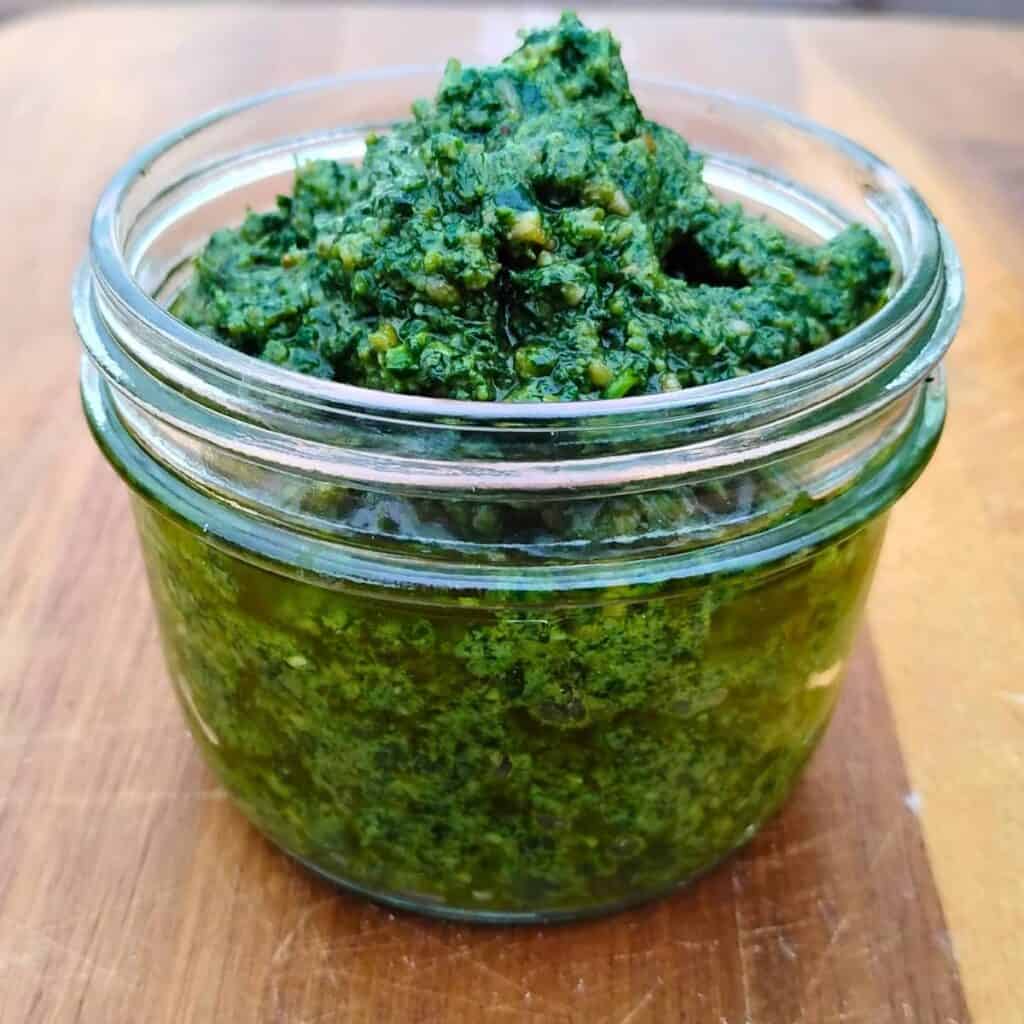
This post contains affiliate links. As an Amazon affiliate, I make a small commission at no extra cost to you if you make a qualifying purchase. See my full disclosure here.
As winter progresses I start craving fresh greens from the garden. But it will be months yet before anything will start to grow there other than a few perennial greens like seakale. This is when I head into the ‘wild’ to see what’s growing. Nature is very good at providing some nutritious greens even while there is still snow covering the ground.
Explore nature’s wild buffet of fresh greens with me and let’s turn these into some fantastic foraged wild greens pesto. What could be better than your first fresh greens of the season to wake up a sluggish digestive system.
If you love wild greens, be sure to check out my article about the wonderful purple dead nettles and you might also enjoy reading about incorporating homegrown edible mushrooms in your garden or food forest. If you wonder what to pair with your pesto, you’ve got to check out my fantastic mushroom risotto recipe! Perfect match! You might also enjoy a pesto made with garlic scapes and bolted onions or onion greens!
- Foraging for wild greens Pesto
- Exploring Nature’s buffet of greens Aka Pick Your Weeds
- Pick Your Weeds
- Stinging Nettles (Urtica dioica)
- Purple Dead Nettle (Lamium purpureum)
- Plantain, broad leaf (Plantago major) or narrow leaf (Plantago lanceolata)
- Clover, white (Trifolium repens) or red (Trifolium pratense)
- Violets (Viola)
- Common Milkweed (Asclepias syriaca)
- Purslane (Portulaca oleracea)
- Sorrel (Rumex acetosa), Sheep Sorrel (Rumex acetosella), Wood Sorrel (Oxalis)
- Henbit (Lamium amplexicaule)
- Ground Ivy (Glechoma hederacea)
- Dandelion (Taraxacum officinale)
- Common chicory(Cichorium intybus)
- Lambs Quarters (Chenopodium album)
- Chickweed (Stellaria media)
- Wild Garlic Grass (Allium vineale) or Wild Onion Grass (A. canadense)
- Ramps (Allium tricoccum)
- Wild Asparagus (Asparagus acutifolius)
- Watercress (Nasturtium officinale)
- Nasturtiums (Tropaeolum majus)
- Winter cress (Barbarea vulgaris)
- Garlic Mustard (Alliaria petiolata)
- Japanese knotweed (Reynoutria japonica) (also called Polygonum cuspidatum or Fallopia japonica)
- Claytonia (Claytonia perfoliata) or (Claytonia virginica)
- Cleavers (Galium aparine)
- A Few Others To Consider
- My Favorite Literature for Plant Id and Foraging
- Wild Greens Pesto Recipe
- How To Use The Pesto
- Enjoy Your Foraged Wild Greens Pesto!
- More Content Like This
- Pin This Post
- Shop This Post
Foraging for wild greens Pesto
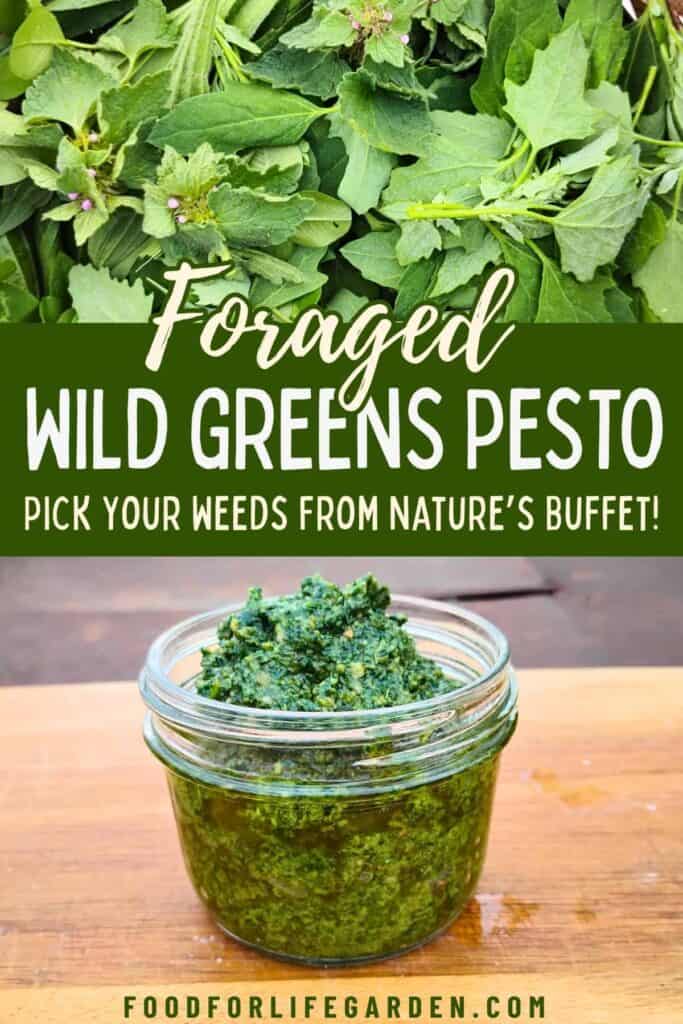
I’m excited that I can finally share with you one of my favorite subjects, that of foraging wild greens. I was hoping to get this post done sooner while all the wonderful very early spring plants are plentiful, but alas, I’m behind a bit. However, you can still find early greens now and this pesto can be made anytime with what greens are available in the wild or your garden too!
Early spring invariably turns me into a forager. While the garden produces many greens and veggies to harvest later in the year, there is a large gap with no greens and few other veggies during the frigid winter.
Once the days warm up a little, the fall planted garlic starts poking their leaves through the mulch, but it will be long before they are ready for harvest. And all the other greens and vegetables have yet to be sown.
So what’s a gal to do if she wants fresh greens at the end of winter? Why, she’ll grab her basket, some clippers, a digging tool and a knife and head out into the wild world that starts just beyond the garden. Or sometimes the wild world spills right over into the garden and is now called weeds.
That’s what I’m after. Nature has so many tasty wild greens waiting to be picked and I’m ready to pick some after a long winter of frozen, dried, and canned foods.
Exploring Nature’s buffet of greens Aka Pick Your Weeds
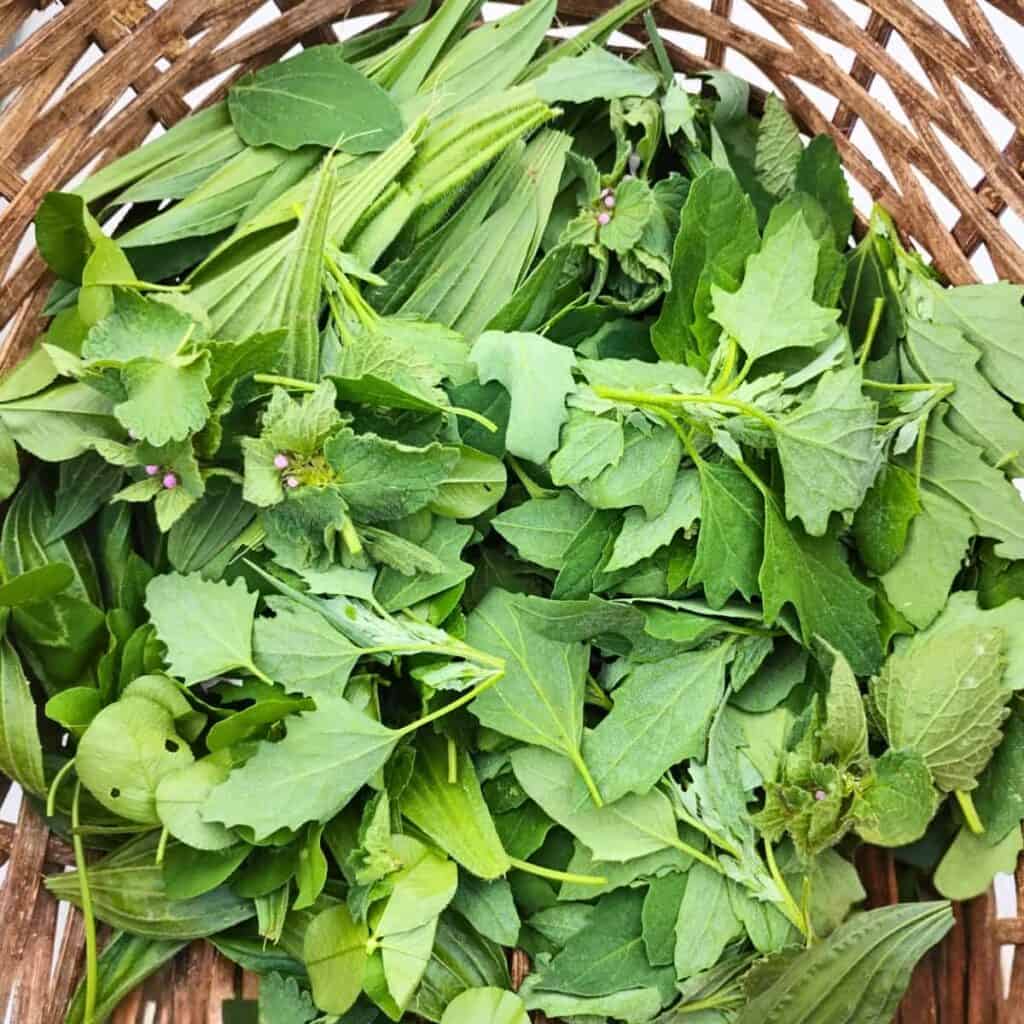
In this post I aim to provide a list of greens that I know of, which would make great additions to a wild greens pesto, to give you some ideas. I’ve added a little bit of information on each, but getting into too much detail would be beyond the scope of this article.
Watch for details on some of these herbs in future posts though. I sure am planning to get into it with my favorites! You can sign up for my newsletter, where I’ll alert you of new content such as this, regularly!
Foraging Ethics And Important Disclaimers
I am not a doctor or claim to be qualified in any way to give medical advice. I am self-taught and this article reflects just my opinions, experiences with herbs, and what I’ve learned from years of studying herbalism, herbs, and their uses. This article is meant for entertainment, reference, and to encourage interest in herbalism. It is my hope to help you get to know and appreciate herbs and their traditional uses.
This article is not meant to help with the identification of wild plants, or to give you medicinal advise for using them. When foraging for wild greens, you should seek out at least two reputable sources of information to identify any wild plants you consider eating. Even better, find a local, knowledgeable human guide. In any case, do your own thorough research! I am not legally or morally responsible for my reader’s health!
And remember to forage sustainably, leave plenty behind for the next person or animal, for the plants to procreate, and take only what you need. Become aware of endangered species and consider growing your own instead of foraging those. Do watch for areas that might have seen pesticide applications. Avoid foraging alongside roads, under power lines, gas lines and other areas that are routinely sprayed. And be aware that invasive species sometimes receive pesticide treatments by conservation organizations, even in the woods.
Pick Your Weeds
So next we’ll explore some wild herbs that grow in places that are wild or not so wild. We’ll be using some in the pesto recipe below, but since herbs vary from place to place and there are many that can be used, I’ve collected a list of possible ingredients for our wild foraged greens pesto, so you can adjust to what’s available to you. Let’s explore some tasty greens…
Stinging Nettles (Urtica dioica)
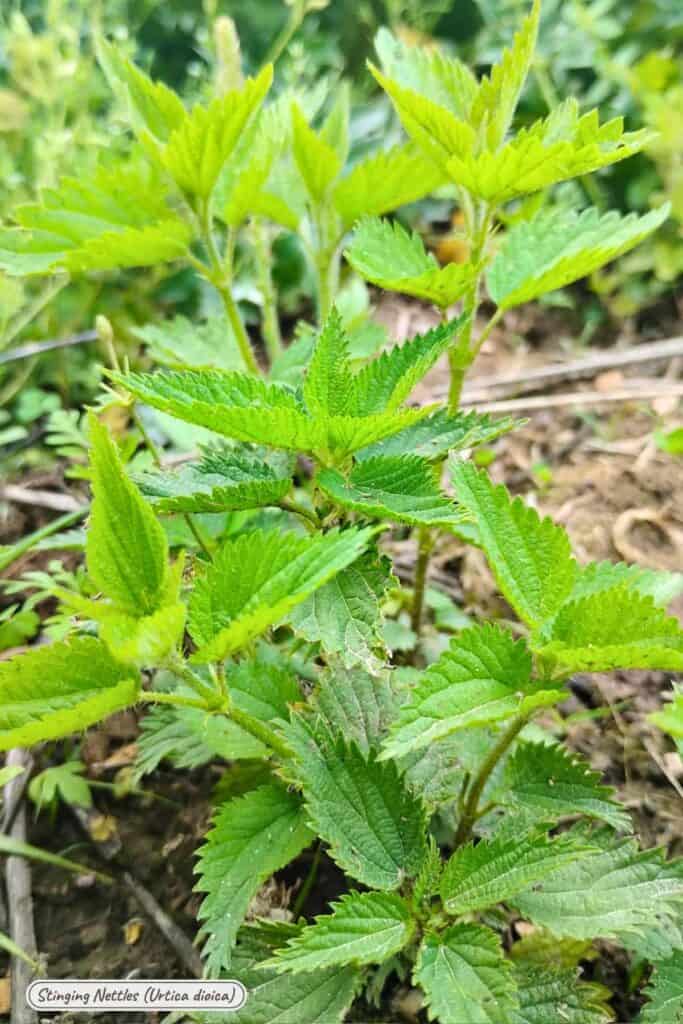
Alright, I’m very partial to Stinging Nettles. They have been my favorite spring green for years. Wherever they grow, they show up in abundance long before the last frost date. In Washington I could start finding them around the beginning of March.
I found that I do not have stinging nettles growing here at my new place, which truly bummed me out, but fortunately my neighbor gifted me a few roots several weeks ago and it looks like at least one patch is taking off. Fingers crossed, I’ll have nettles to eat next spring!
Stinging nettles deserve a whole post for themselves and one of these days, I’ll get around to doing them justice. They are just such awesome herbs and make tasty and nutritious vegetables. They are a powerhouse of medicinal benefits. As a vegetable, they need to be cooked or at least well wilted by steaming so the little hairs lose their sting. And they are great stir-fried or in a soup.
Check this out though: I read somewhere that if the nettle leaves are crushed, as with a rolling pin, they are supposedly ok to eat raw, since this destroys the ability of the hairs to sting. If you want to try that, go ahead, but I’m not that adventurous.
When they go into my pesto, stinging nettles get either steamed or blanched for 1-2 minutes first! And boy, does it ever make great pesto!
Purple Dead Nettle (Lamium purpureum)
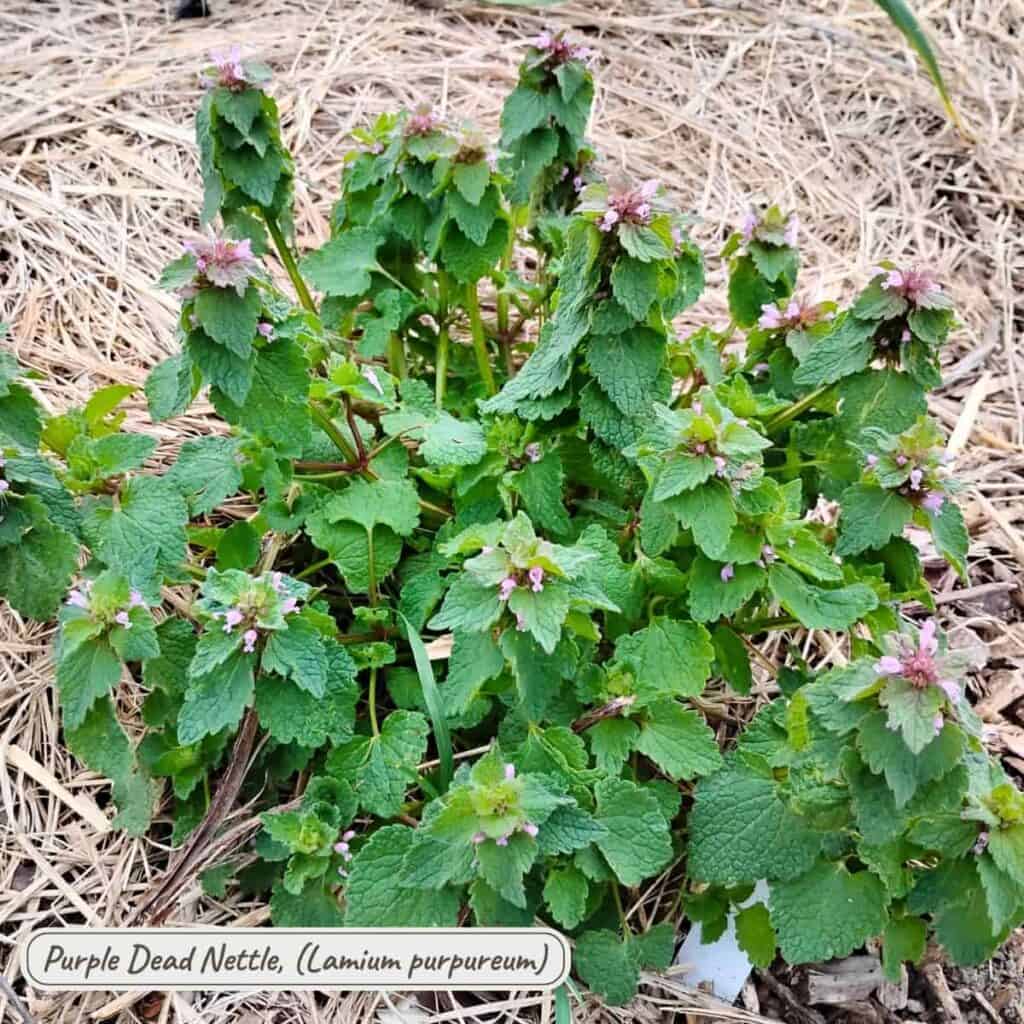
This common herb likes to grow in large patches once it gets established in an area. The purple dead nettle is a super useful medicinal plant and makes a highly nutritious vegetable. If you are frustrated with this one, because it’s growing a little overabundant in your garden, pick it and eat it and you might just start to love having it around.
The purple dead nettle is a winter annual and will start growing even through snow, very early in spring. It will be available till summer usually, and then it will die after it is done making seeds.
Purple dead nettle is great in stir-fries, egg dishes and soups. Go check out my post about the purple dead nettle and its many benefits. You’ll also find instructions to extract those benefits in a purple dead nettle tincture for year round use.
Raw purple dead nettle leaves and flowering tops are a main ingredient in my pesto today.
Plantain, broad leaf (Plantago major) or narrow leaf (Plantago lanceolata)
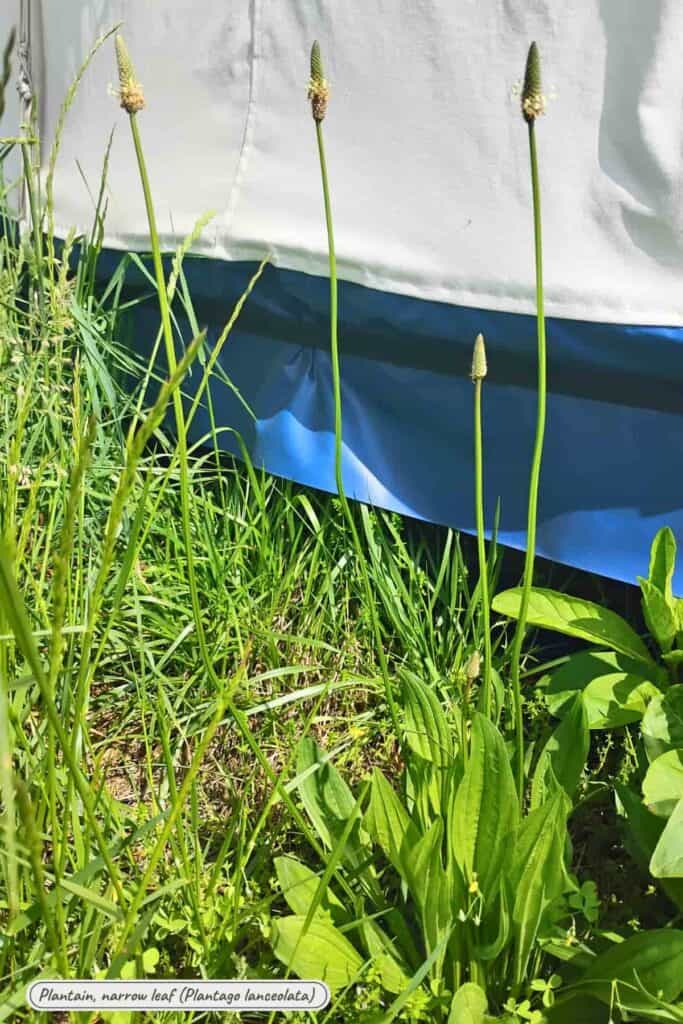
Plantain seems to be everywhere! I find it especially in mowed areas, alongside roads, in driveways, and in areas that have been disturbed in recent years. Plantain is a perennial plant that originated in Europe and Asia. It is found all over the United States now.
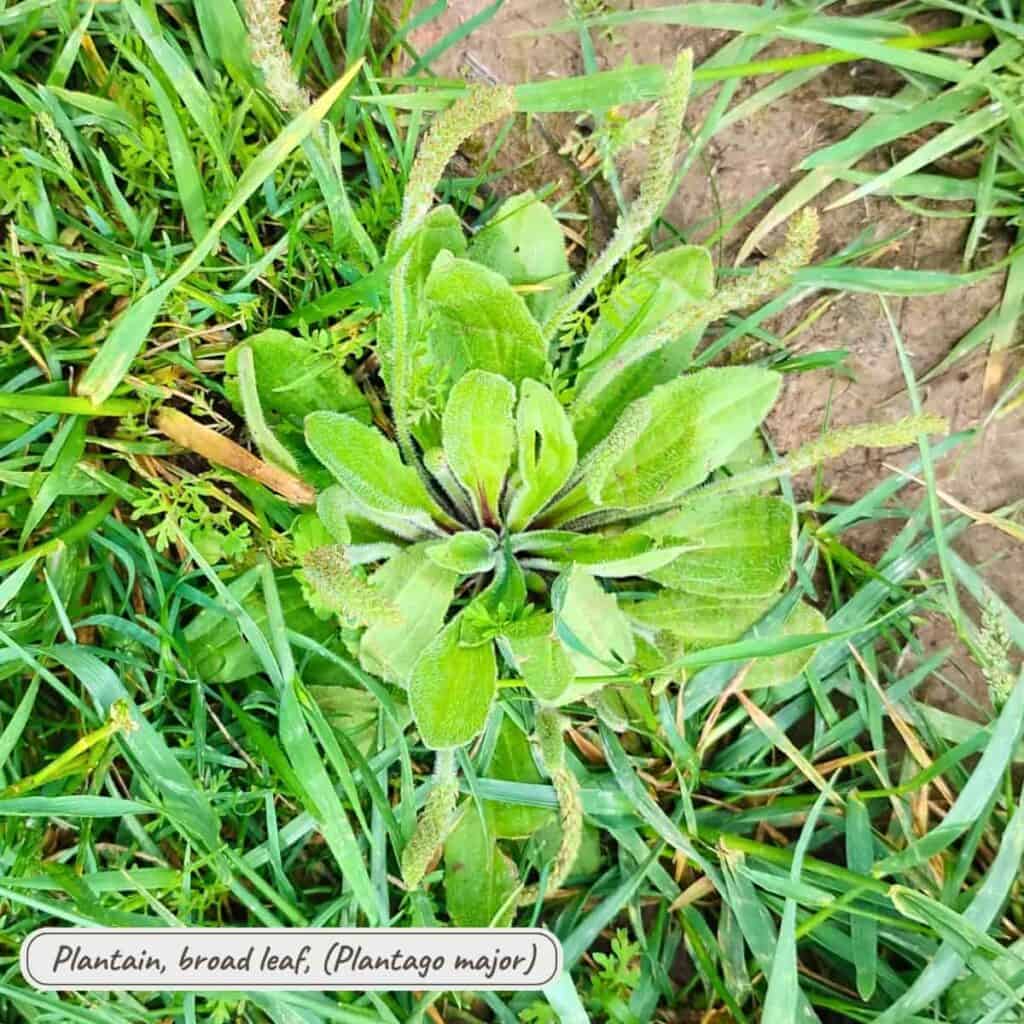
Historically, plantain is an important medicinal plant which is often used for wound care and to stop the bleeding. It is also used for digestive and respiratory issues. It is anti-inflammatory and analgesic. And its seeds contain psyllium, an important fiber for gut health.
Plantain is also a great vegetable. The leaves make tasty salad greens when young and can be used in soups and stews even when older. The seeds can be dried, ground and used as a flour, and the root can be used in soups and stews as well.
Raw plantain leaves are a main ingredient in my pesto today.
Clover, white (Trifolium repens) or red (Trifolium pratense)
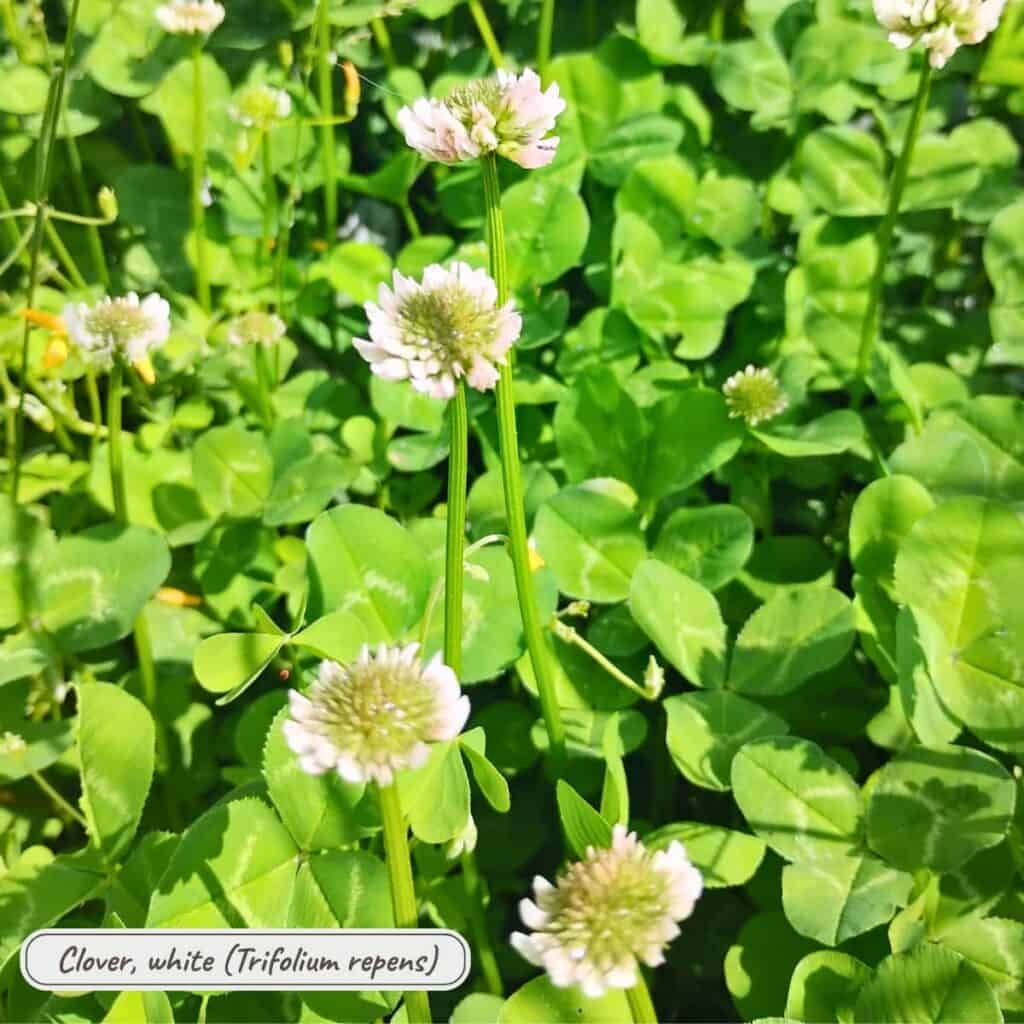
Some varieties of clover are not edible, but our common white and red clover are considered edible raw or cooked. Both the leaves and flowers can be used. The flowers should be cooked to be easier to eat or use them in teas. Clover is high in protein and vitamins.
However, there are some contraindications found for clover, such as the fact that a fungus can grow on them which is toxic to humans.
Another problem lies with white clover in that it can produce cyanide to ward off pests. This can be eliminated by cooking the clover. In an interesting article the discussion mentions that in cooler climate clover does not produce cyanide, but in warmer climates it does. There is also a factor that urbanization actually lowers clovers cyanide production as per UC Davis.
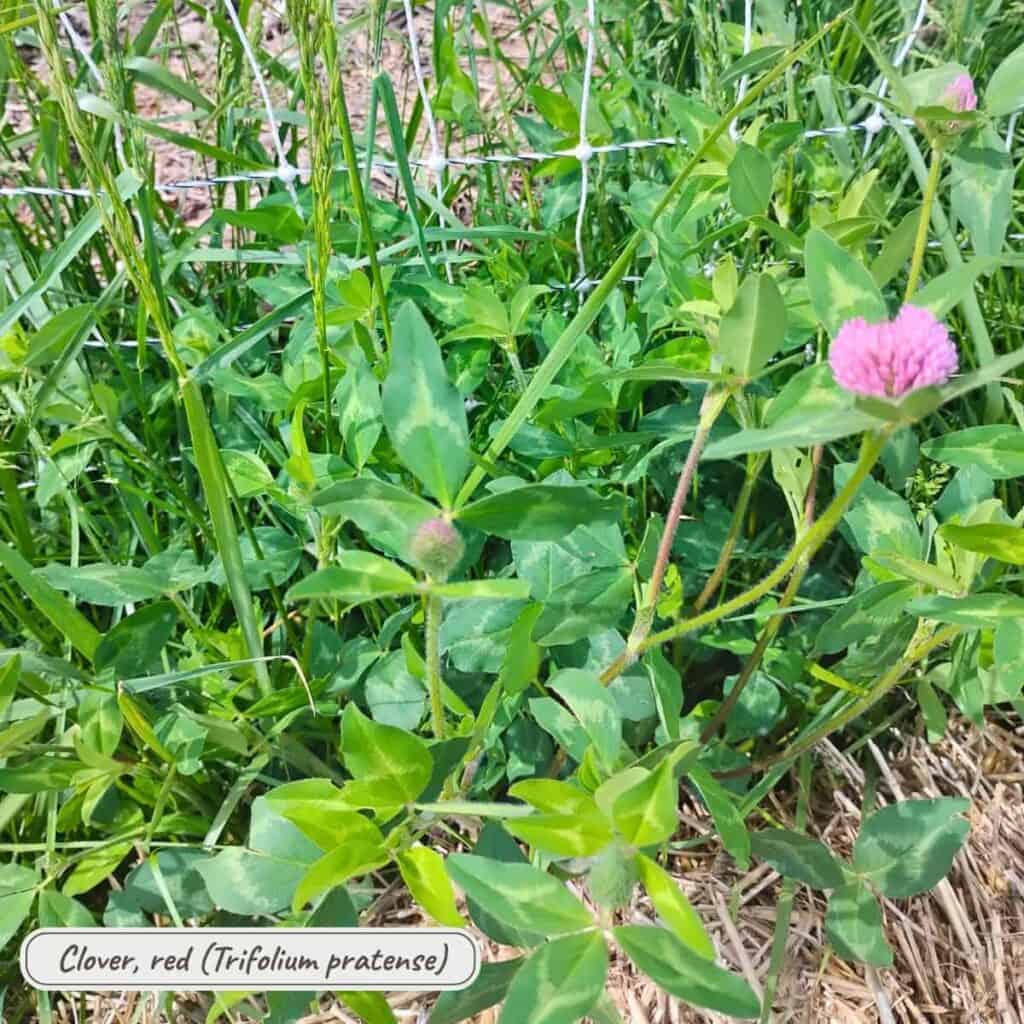
Medicinally, red clover has powerful properties that are useful for menopause, cancer, cholesterol, bone health and skin conditions. White clover is associated with supporting the lymphatic system and addressing gout and kidney problems.
Sooo… In my opinion it’s not worth the risk to eat white clover leaves. I live in the south and in a rural area, both indicators for higher cyanide production. But if you live in urban environments or in a cool climate it might be ok to eat white clover leaves raw. I’ll stick with picking the leaves from the red clover for my pesto and I make sure that I pick only from healthy looking plants.
I did use a small handful of raw red clover leaves in my pesto today.
Violets (Viola)

These beautiful little plants are scattered throughout my pasture and in the woods around me. I forgot to add them to my pesto, but both the flowers and leaves are edible, and the flowers are so beautifully decorative when tossed over salads and other dishes.
Violets are also popular medicinal plants that have been used for swelling, inflammation, pain, eczema, acne, cancer, and lymphatic flow. You can find more about violets in this interesting article.
All the Viola plants are edible (pansy, viola odorata, johnny jump-ups etc.) I would include the raw violet leaves in the pesto and decorate it with the flowers when serving it for dinner.
Common Milkweed (Asclepias syriaca)
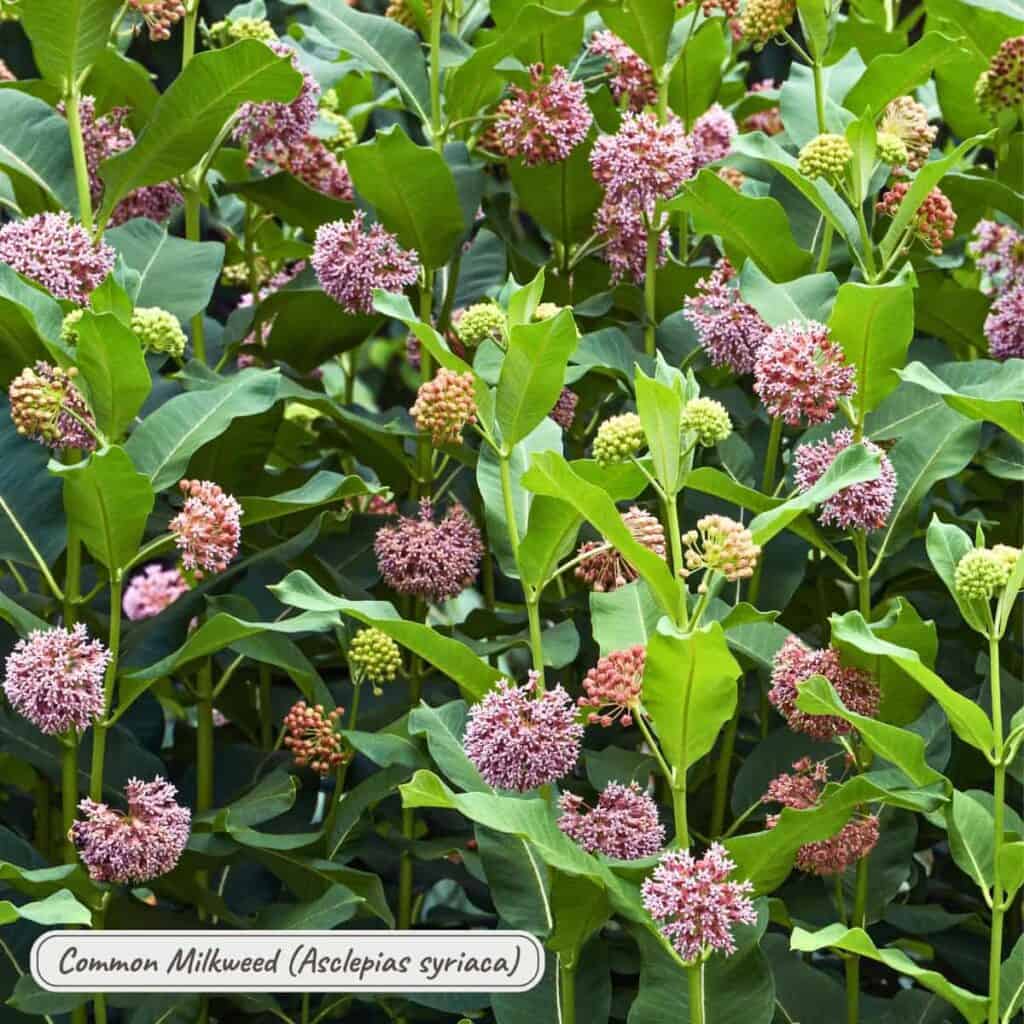
The common milkweed is edible and its pretty flowers make a beautiful decor sprinkled over your desserts or salads. Because milkweed is essential for the Monarch butterfly’s survival, it should be harvested sustainably and sparingly.
The young, tender leaves are good for eating but they can become tough as they mature. The young shoots, unopened flower heads, and young seed pods are also all considered edible.
All milkweed parts should be cooked to denature any toxic compounds and flowers might be used raw in very small amounts for decorative purposes. Read more about foraging milkweed here.
And you’ll want to be sure to take care identifying your common milkweed plants (it has purplish-pink flowers), as other varieties of milkweed are likely toxic. In addition the shoots can be mistaken for dogbane shoots, which are toxic to humans. If they taste bitter, do not eat them, they are not common milkweed. Check out this interesting article on milkweed.
I thought this was a cool bit of information: milkweed stems were used by indigenous people to make fibers! It was found in prehistoric textiles.
I did not use milkweed, as I’m not too familiar with the plant yet, and haven’t found any in the wild, probably because I wasn’t looking for it. Though I did buy seeds to plant them in my food forest as pollinator plants. Only the common milkweed is considered edible out of all the varieties.
I would totally consider using milkweed leaves for pesto once I can ID them properly, but only after cooking them.
Purslane (Portulaca oleracea)
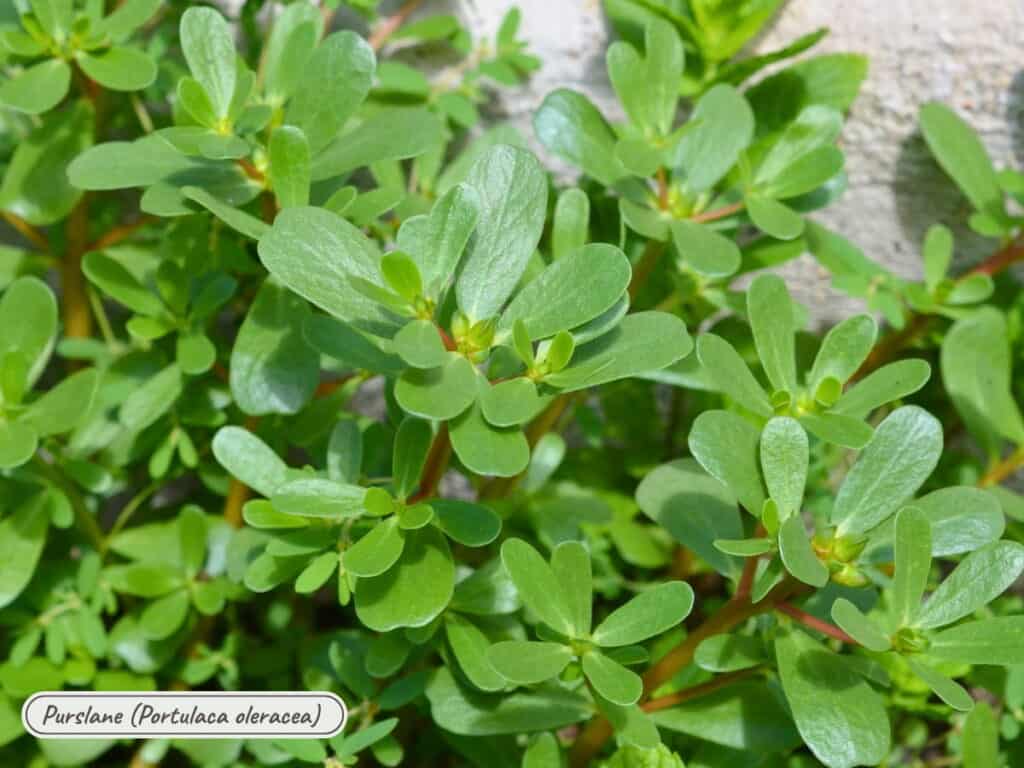
I love purslane, but it’s not growing here at my new location in Missouri. Maybe I just have to be patient, but I had it growing wild in abundance in Washington State. There it grew all through my garden and I used it all summer long in stir fries and soups. It makes a great ground cover too for taller vegetables.
In Washington, I had access to so much purslane that there was enough to preserve some. I froze several packets of it, and fermented a few jars, and I canned some, which actually turned out really great. The canned purslane was handy to dump into a winter soup, juices and all for a bit of a tangy flavor.
Purslane packs some serious nutritional power, it is rich in vitamins A and C, minerals such as potassium, magnesium, and iron, and omega-3 fatty acids, especially alpha-linolenic acid.
My neighbor said it grows in her yard, so I might be able to get a few plants from her to get it to start growing in mine. It can also be grown from seeds. Purslane has mucilaginous leaves and a lemony flavor. It can be eaten raw in salads or cooked. Normally I prefer it cooked.
Purslane also has medicinal benefits and has been used for its anti-inflammatory properties, for heart health, liver health, wound healing and as a muscle relaxant. It is also a good source of antioxidants.
I would totally use raw purslane in my pesto if I had some growing here.
Sorrel (Rumex acetosa), Sheep Sorrel (Rumex acetosella), Wood Sorrel (Oxalis)
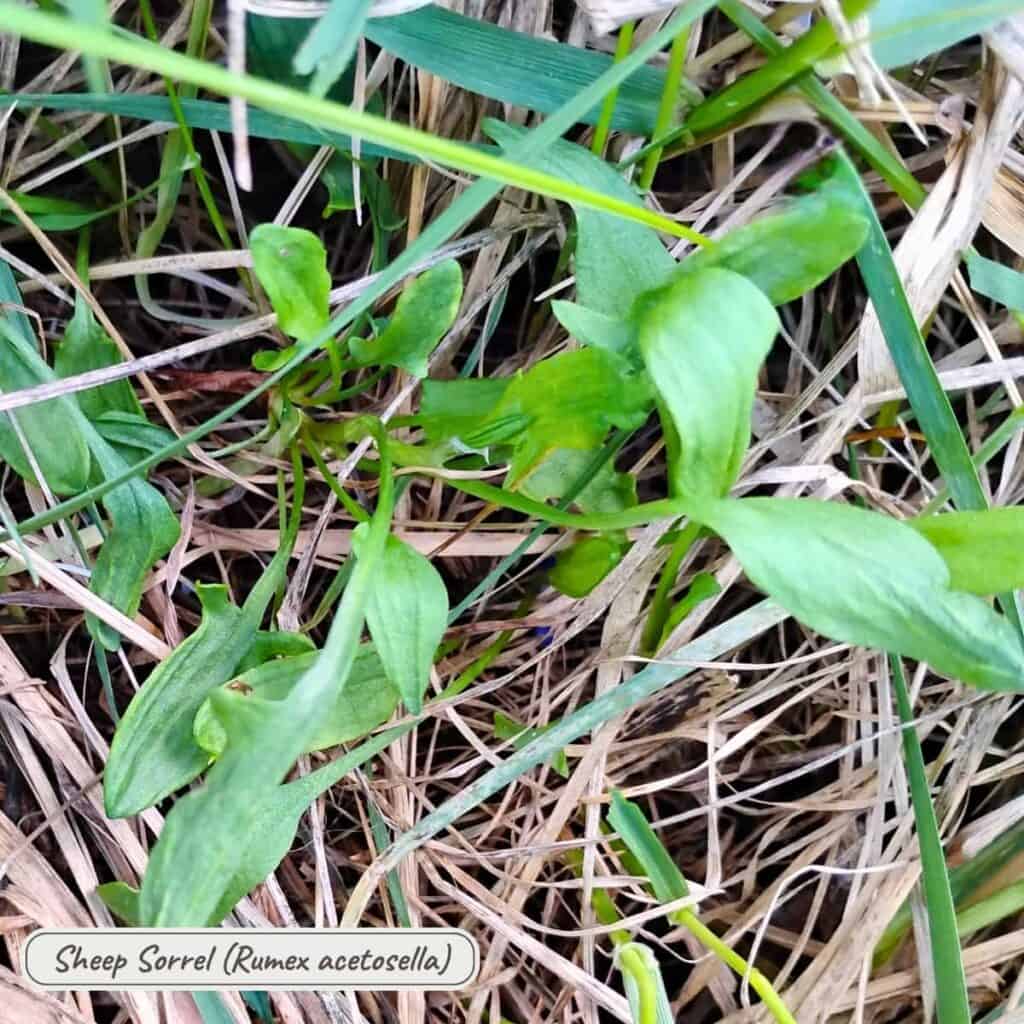
I’m very fond of sorrell. Sheep sorrel was another herb that grew in abundance in the PNW Washington woods and my garden. I often picked a few handfuls of the leaves to add to my lemony summer soups or lemon chicken noodles. I think it goes great with summer squash dishes!
I also tried preserving it, but that didn’t work well, it kind of turns to mush when cooked. However, I’m thinking if I get lucky enough to have plenty of sorrell again, I would try preserving it with salt as I do with parsley, dill, and basil.
I do miss many of my favorite wild greens from the past and hope to eventually run into them here in Missouri. And if my neighbor has them growing, I’ll help them make their way to my pad! They wouldn’t be exactly wild, but they wouldn’t be cultivated either, I’d just be helping them to spread, lol.
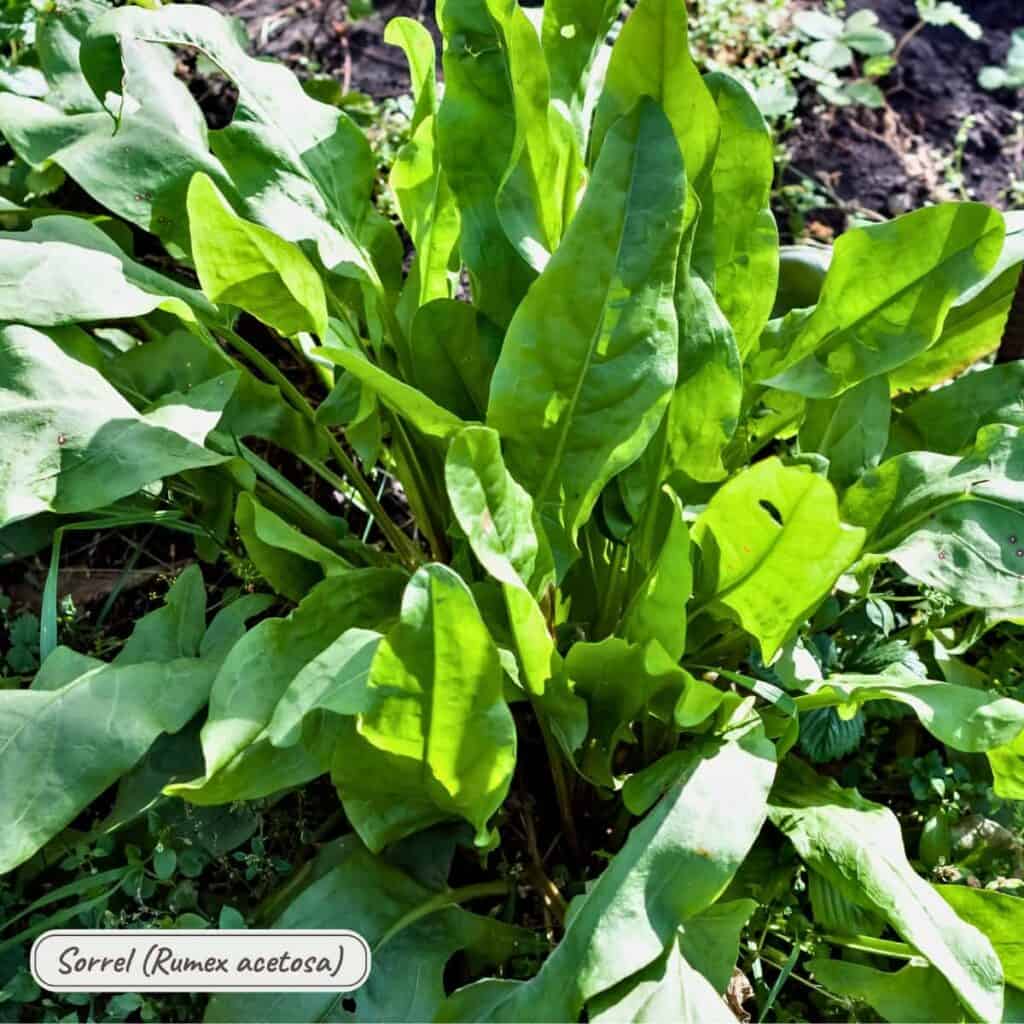
Sheep sorrel is the only one I recognized in the wild. Rumex acetosa, often called the garden sorrel is a wild sorrel as well, but is very often cultivated in the garden for greens.
Wood sorrel is a different genus (oxalis) that I found plenty of in Washington. There was plenty of the purple variety, which looked striking against the bright green spring grass. I did find a few small patches here in my Missouri garden, but with green leaves.
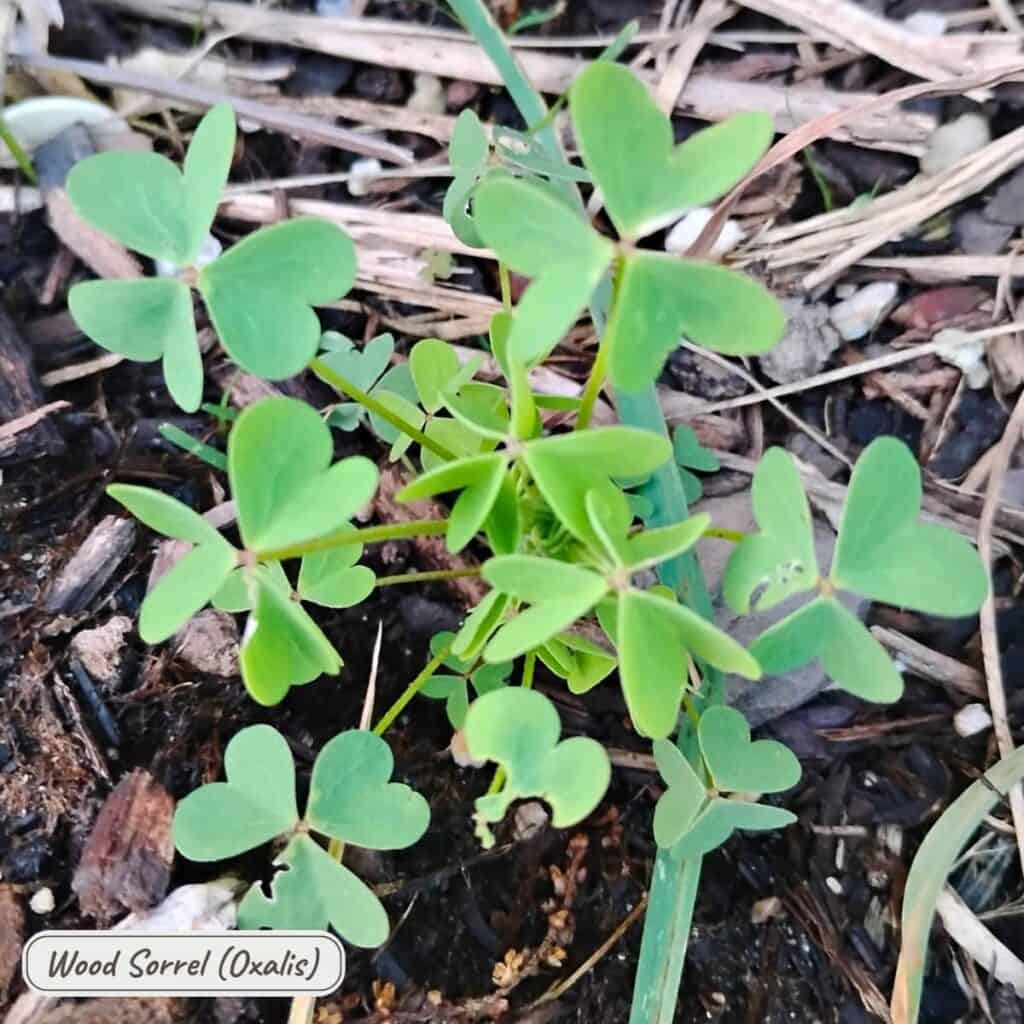
So far, most of the wild greens and weeds that I have found here on my Missouri land, are either prickly or poisonous or both. I did find one sprig of sheep sorrel next to my BBQ grill and I’m hoping that it will go to seed, so I can maybe spread it around a bit. As I’m turning a part of a previous pasture into a differnet ecosystem by establishing a food forest, some of my old beloved herbs might start appearing. We’ll see.
Sorrel has many powerful health benefits. It is especially high in antioxidants. It has neuroprotective properties, and is sometimes used to support heart health. Some studies show that it has the ability to kill cancer cells.
Sorrel contains oxalates, and so if you want to eat it regularly, you should consume it with extra calcium to prevent calcium deficiencies.
I would totally add raw sorrel to my pesto if I found more than a sprig here.
Henbit (Lamium amplexicaule)
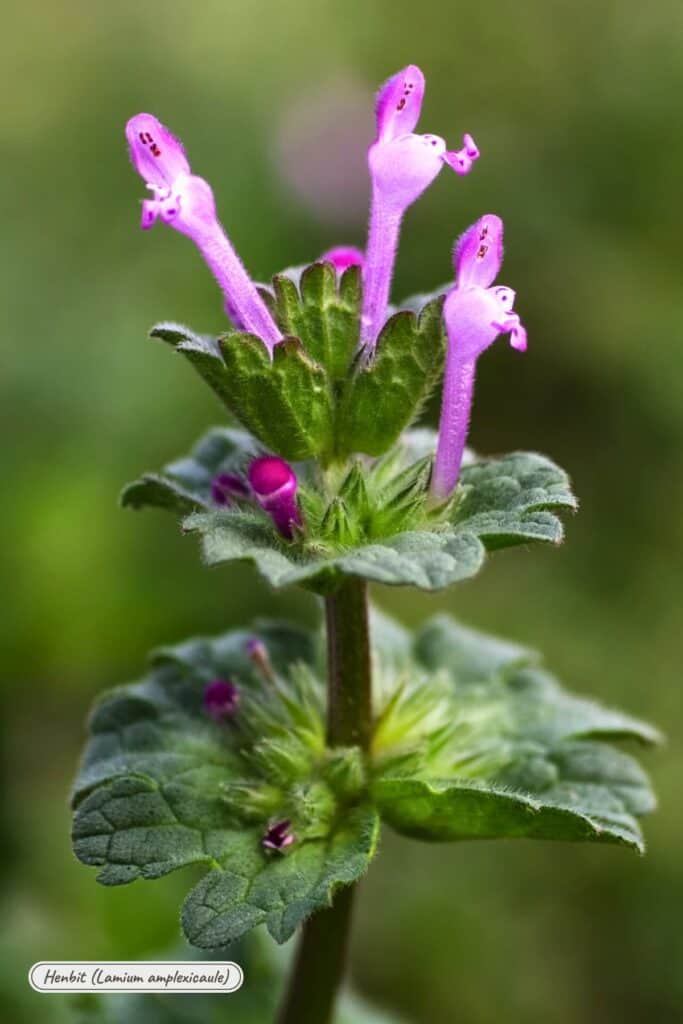
Henbit is a type of dead nettle and has many similar benefits as the purple dead nettle. It often grows right alonside the purple dead nettle too. Here is a page for henbit identification.
Henbit is anti-rheumatic and anti-inflammatory and is used for pain relief of chronic pain. It is used for digestive support, to boost energy, to relieve anxiety, and for skin healing as it is astringent, antiseptic, and anti-inflammatory. It is rich in vitamins and minerals too.
All of the henbit is edible and I would use it raw in my pesto if I could find it growing here.
Ground Ivy (Glechoma hederacea)
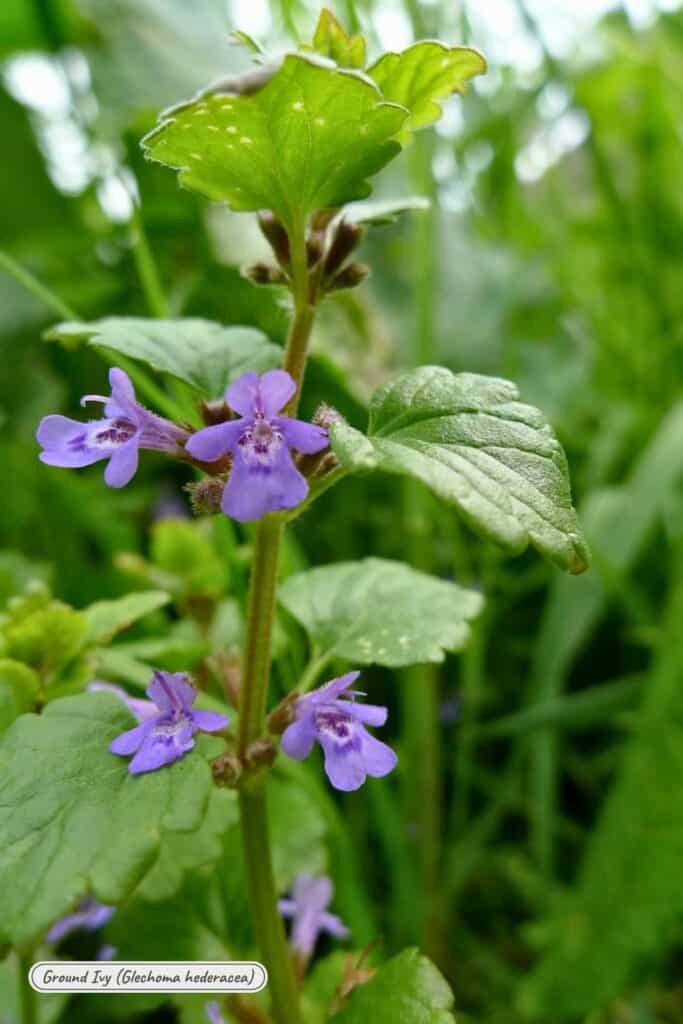
Also known as creeping Charlie. This little guy is also edible and is sometimes confused with the purple dead nettle. It can be eaten raw in salads, or cooked in soups, egg dishes, and stir fries.
In days of old, even before hops were used, ground ivy was used by brewers to clarify and flavor beer. And the fresh plant was served battered and fried as a side with the beer (source).
This useful plant has some important health benefits too. It can help with respiratory issues, digestive issues, joint pain and arthritis, headaches, tinnitus, and skin conditions.
If I could find Ground Ivy, I would love to add the raw leaves to my pesto!
Dandelion (Taraxacum officinale)

And who doesn’t love dandelions? Anyone? I have been a fan my whole life. We used to pick the flowers with stems attached, cut into the ends of the stems and put them into our mouths and started talking. This would cause the stem ends to curl up into wacky, funny shapes.
And what kid doesn’t love blowing dandelion seeds off the seed heads to watch them fly like little helicopters! I remember begging my dad not to mow the lawn when the dandelions were in flower because I thought they were the prettiest flowers and I still think they are gorgeous!
As kids grow up to be adults, somewhere along the way they loose their affinity for the lovely dandelion and suddenly they want to kill those pretty and useful plants. What made that shift happen?
Thankfully I never quite grew up and so I still love dandelion plants and don’t even like to mow the flowers down when I see them. And as I grew older I also grew to appreciate the awesome medicinal benefits that the dandelion gives to us so generously. How can I not appreciate this plant. Wow, it’s packed with goodness.
A long time ago I bought a book that has been one of my favorites over the decades that I’ve had it. Here is a link for it, it’s available on Amazon, but they only have used copies, so this link might not work, but look for ‘A Dandelion Celebration‘ by Peter Gail. It has lots of recipes for greens, flowers and roots, how to make dandelion beer and wine, some history and health benefits.
Anyway, this book did much to seal my love for dandelions and so I continue to cherish the awesome dandelion! Pick the young and tender leaves as the older ones get quite bitter. The root, when picked in the late fall or winter, is also great for cooking and it can be roasted and ground to make a super healthy coffee substitute.
The leaves are highly nutritious and it boasts potent antioxidants and anti-inflammatory properties. It has bioactive compounds that can lower blood sugar, it may lower cholesterol and blood pressure and promote liver health. It supports healthy digestion, may have anti cancer effects, can boost immune health, promote healthy bones and more (source).
I love to use some of the young, tender, raw dandelion leaves in my pesto.
Common chicory(Cichorium intybus)
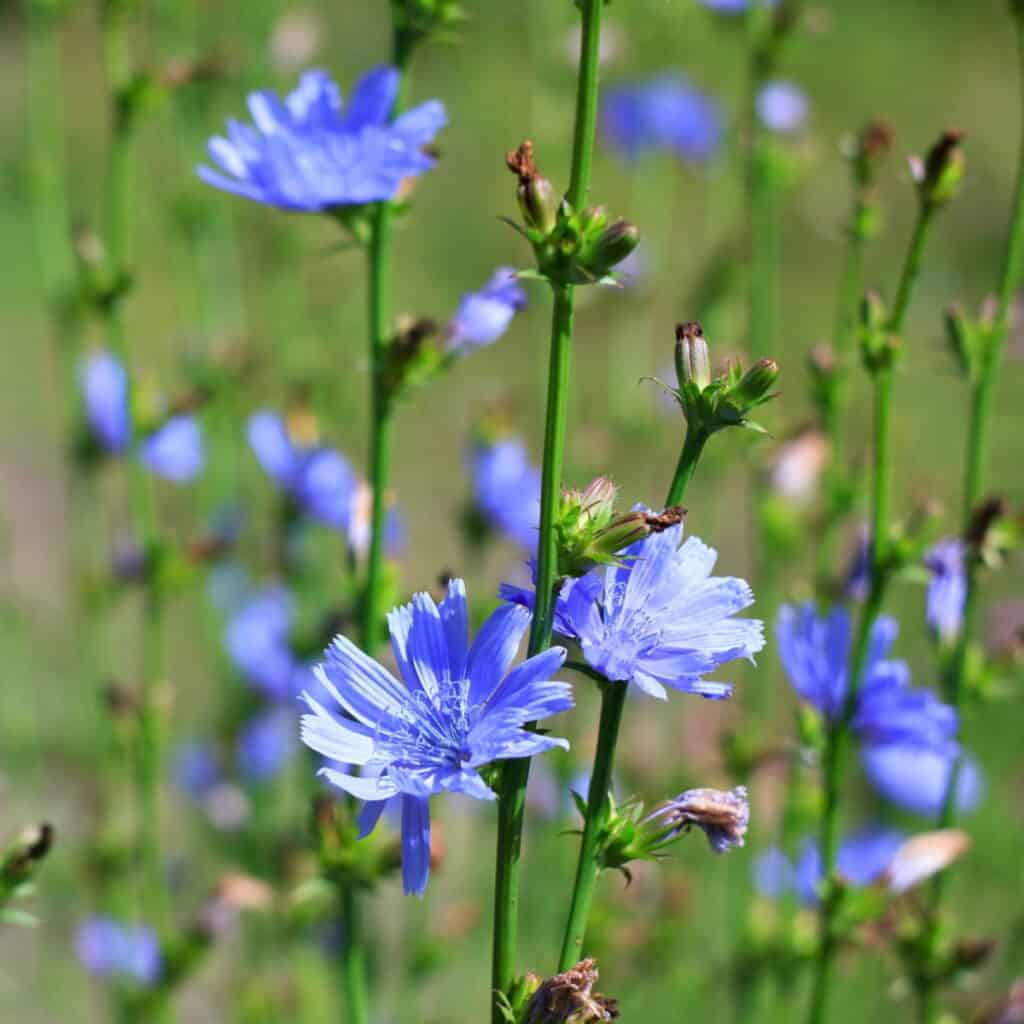
Chicory is related to the Dandelion, and can be used in much the same way. They have similar medicinal properties and are very nutritions. Chicory is known for supporting liver health, the digestive system and regulating blood sugar levels.
All the parts of chickory are edible. Chicory flower buds can be pickled, the flowers and young leaves can be used in salads. Avoid using the leaves during the summer, as they will be more bitter. They are less bitter when young and fresh in the spring.
The root of the chickory is often made into a roasted vegetable, used in soups and stews, or it can be roasted and ground into a coffee substitute, that is super healthy and great for the liver. I use half ground coffee, half roasted chickory crystals every day when I make my brewed coffee. I actually think it improves the flavor of the coffee and makes it taste richer. You can buy the roasted and granulated chicory root if you don’t want to make it yourself.
Chicory root can also be forced in the winter in a dark room, to produce blanched greens, which are popular in Germany for winter salads mixed with oranges and toasted nuts.
Chicory’s leaves are easily confused with that of the dandelion, but chicory’s are more hairy than those of the dandelion. Both exude a milky sap when picked.
It grows abundantly in my field and I will have to go and mark out the spots where it likes to grow this summer when they are in bloom, so I can havest some of the roots. Chicory is biennial, so it will bloom and then die. It reproduces easily from the seeds.
I am planning to find some chicory in my field and add the raw leaves to my pesto this fall once I can locate them in the tall grass.
Lambs Quarters (Chenopodium album)
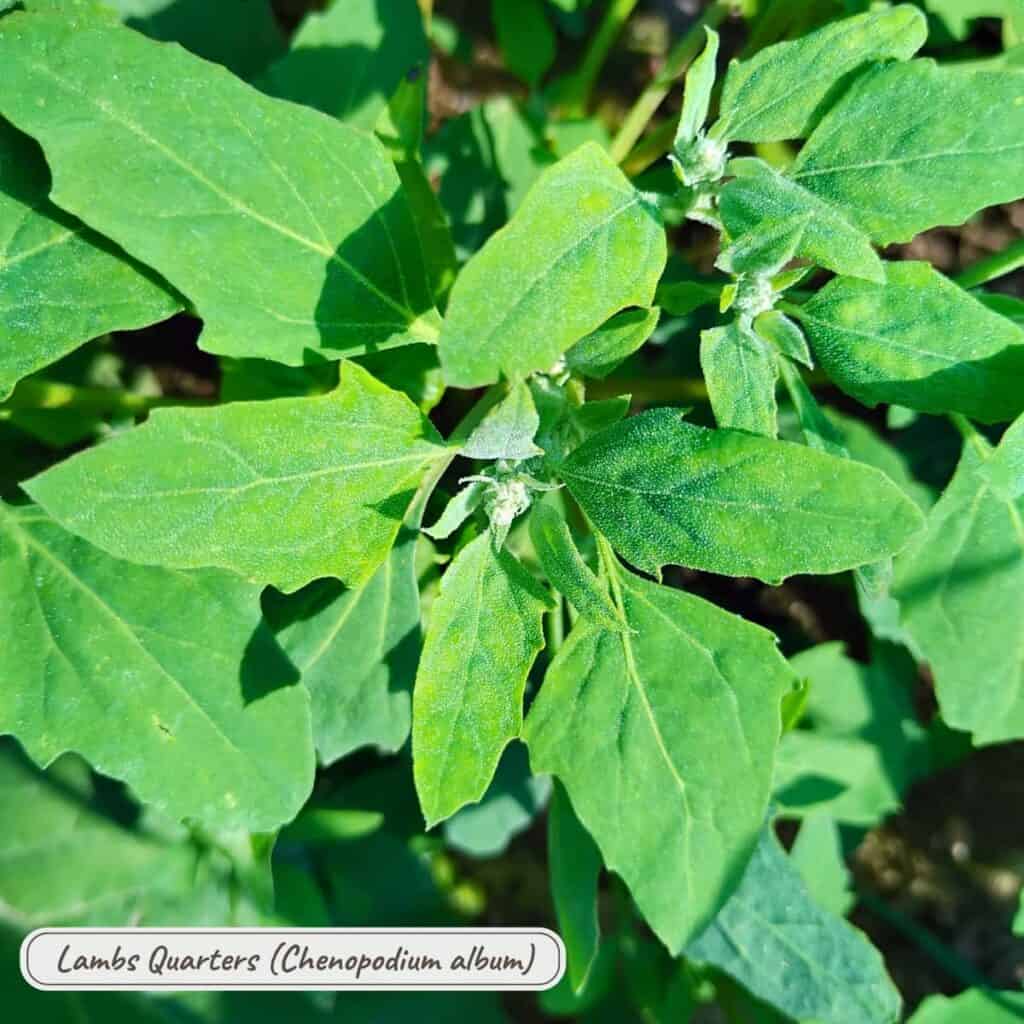
Here is another plant that I’m a huge fan of! Lambs quarters, also called white goosefoot, has better nutritional value than spinach. And I have seen them wherever I have lived. They grew abundantly in New Hampshire, Washington and I’m finding plenty here in Missouri too.
They can get a little unruly in the vegetable garden, and so it’s a good idea to use them as vegetables until they start making flowers and then cut the whole plant and feed them to the goats or pigs. They all love them.
However if you want to be self reliant, consider that the seeds can be dried and ground into flour! It is very similar to Amaranth. The seeds can also be cooked like cereal grain, or rice.
Before the introduction of spinach, lambsquarters was highly regarded as a green vegetable. It can be eaten raw or cooked. In fact, according to Samuel Thayer in ‘The Forager’s Harvest’, historically white goosefoot was cultivated in plantations for its seeds and nutritious greens.
Lambs quarters are high in vitamins A and C, riboflavin, niacin, calcium, manganese, potassium and iron. Lambs quarters even beats spinach as a storehouse of protein, calcium, phosphorus, iron, vitamin C, and vitamin A, and it can pull minerals from deep in the earth with its strong, deep taproot. (source)
I did include a good amount of raw lambs quarters leaves and tops in my pesto today!
Chickweed (Stellaria media)
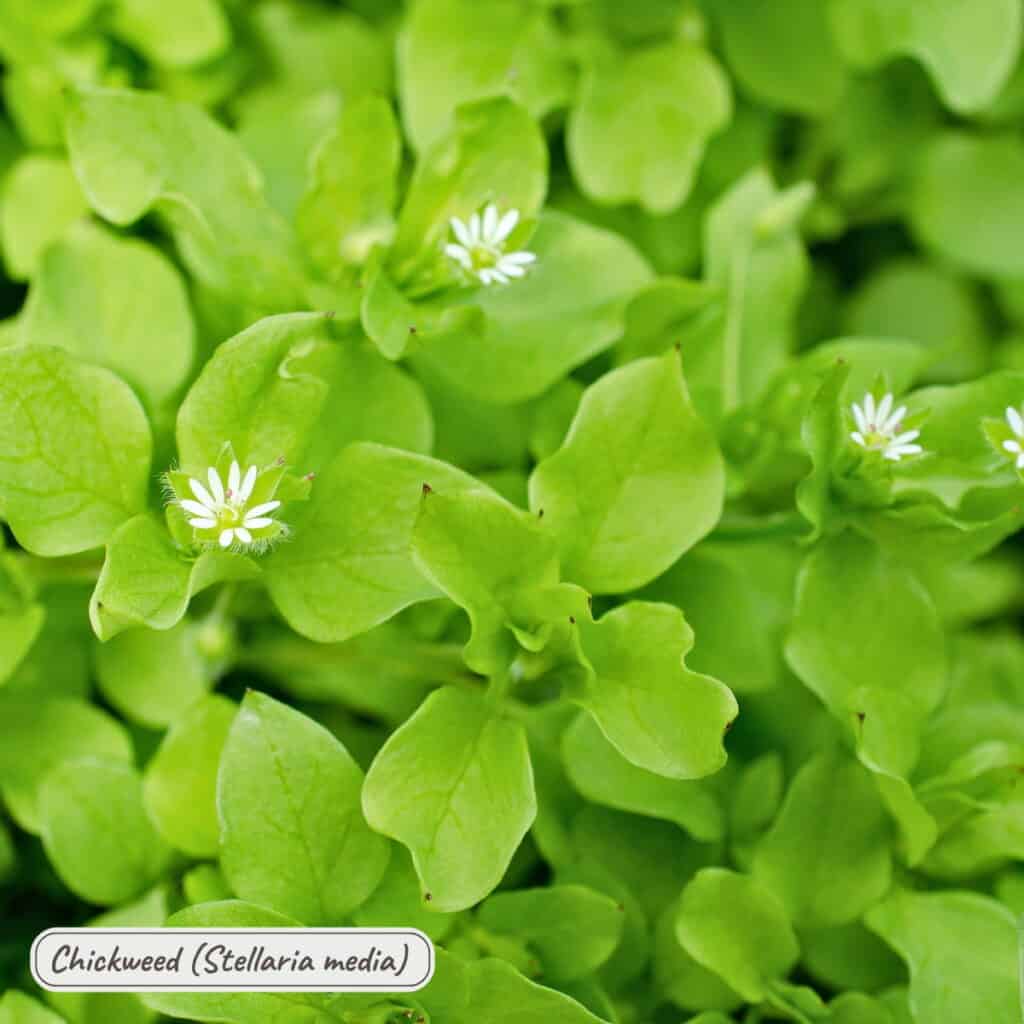
What can I say about chickweed. This is a dainty, lovely plant with the pretty star shaped flowers, which helped earn it the name stellaria! It’s one of my favorite wild greens to eat in salads, made into smoothies, and just eat plain when I’m outside and encounter it.
I fell in love with this weed after reading Susun Weed’s ‘Healing Wise‘, which introduced me to chickweed many decades ago. I was really disappointed that it wasn’t growing at my new place, but I found it just today when visiting my neighbor, where it grows all over behind her shed. You can’t imagine how delighted I was to find it there. She let me dig up a patch and I took it home to plant it here. I hope it takes off!
This plant does contain saponins, however, they are poorly absorbed by our bodies and so it is considered fine to eat in moderate amounts. Chickweed should probably not be eaten in large quantities and not by pregnant or nursing women. Chickweed is nutrient dense and is rich in vitamins A, B complex, C, and D, as well as minerals like calcium, potassium, and iron. It is also a good source of protein and fiber.
Chickweed has many medicinal benefits as well. Dr. Axe mentions that it can reduce inflammation, increase antioxidant intake, support gut health, reduce pain and improve skin health. It is a good source of vitamins and antioxidants, has anti-inflammatory properties, may help with diabetes and support the heart. It is astringent and diuretic.
Pfaf.org has a list of benefits as well and calls it an effective herb for any kind of skin conditions and to help with severe itching of the skin where other treatments have failed. I’m listening!! I’ll have to try it on those nasty tick and chigger bites that I’m encountering quite regularly here in Missouri. They are pure misery! You might also try it on eczema, acne, poison ivy, bug bites, rashes and more.
I love eating raw chickweed and it goes into my pestos whenever I can find it. I made lots of chickweed pesto in Washington and put all the extra into the freezer for year round use. Pick it before it goes to seed for best flavor and tenderness.
Wild Garlic Grass (Allium vineale) or Wild Onion Grass (A. canadense)
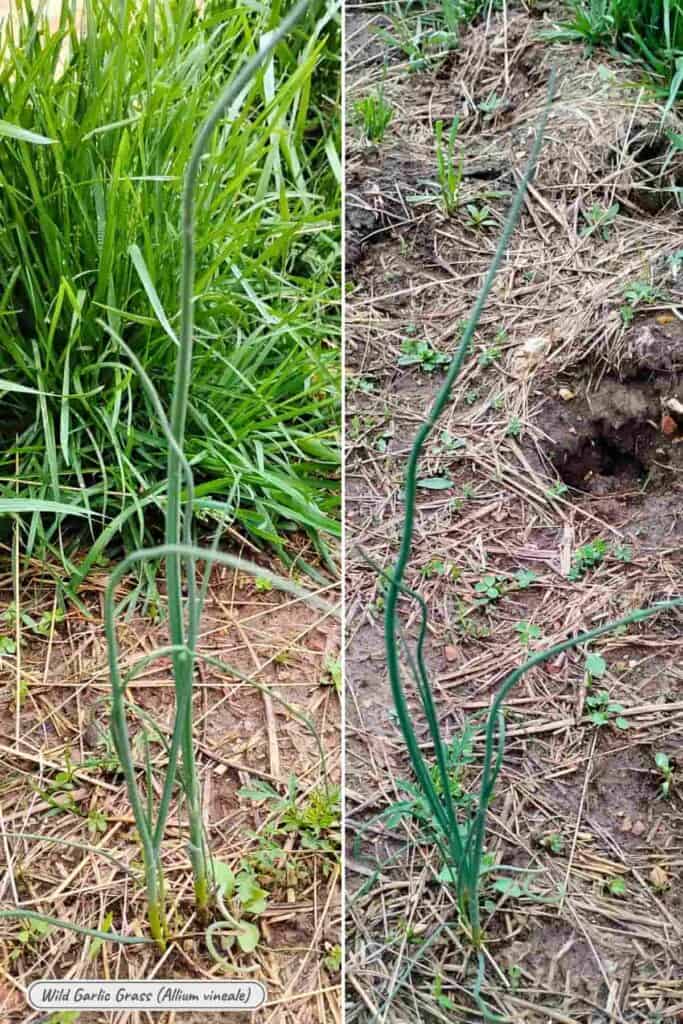
And here we’ll talk about garlic or onion grass. I looove that I have garlic growing wild all over my place. I planted a bunch of the domesticated type, but hey, I can always use more and garlic is a primary ingredient in my pesto!
All of the garlic grass can be used, bulb and greens. It has that delicious, unmistakable garlicy smell to it, and when I weed whack me a path to walk on, I can smell it in the air.
I read that it can be invasive. Some people do not love to have it around, but I think it’s awesome. Except maybe when it pokes right through my very tightly woven ground cover that I keep in a few places to keep the weeds down. Garlic grass defies it and will push right through this tough fabric like a needle. Strong stuff!
Onion grass is similar. Apparently, the two are distinguished by their leaf shape and smell. If it smells like garlic and has hollow round leaves, it’s wild garlic. If it has flat leaves that are not hollow, it’s onion. I find that interesting, because the domestic onion and garlic are opposite, but I got this info from the Missouri botanical garden, and they oughta know!
The nutritional value in both wild garlic and onion are the same or better than that of the domesticated kind. So they are very valuable to have around in my opinion.
And yes, raw wild garlic grass is a majorly important ingredient in my pesto. If I didn’t have it, I’d use my domesticated garlic cloves or garlic scapes.
Ramps (Allium tricoccum)
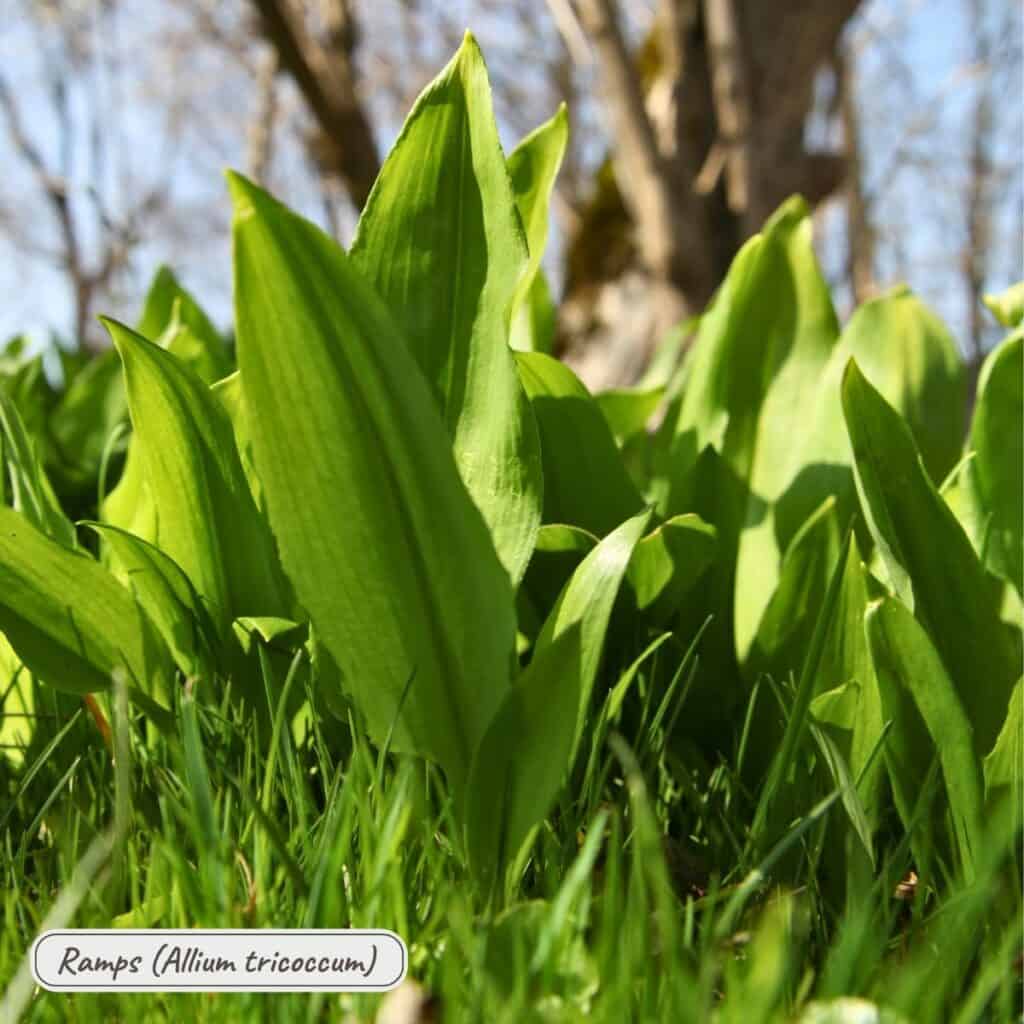
Another great garlic treat are the early season ramps, also called wild leeks, ramson or bear’s garlic. If you can find ramps, they should make a super tasty addition to your wild greens pesto instead of garlic.
There is a bit of concern about it being over harvested because of its recent popularity. People dig it up and sell it in quantity to restaurants or at markets. If this is not sustainably done, it can quickly deplete resources.
So let’s not do that and be careful to not over harvest an area, take only a few leaves from each patch and only what you need. Leave the bulbs in the ground so they can keep reproducing. Ramps are perennial. My plan is to get some seeds and establish them in my woodland near the creek. It’s nice and moist down there which ramps love.
Ramps has similar nutritional value and health benefits to other allium plants such as garlic, leeks and onions.
I would definitely add raw ramps leaves to my pesto if I found some!
Wild Asparagus (Asparagus acutifolius)
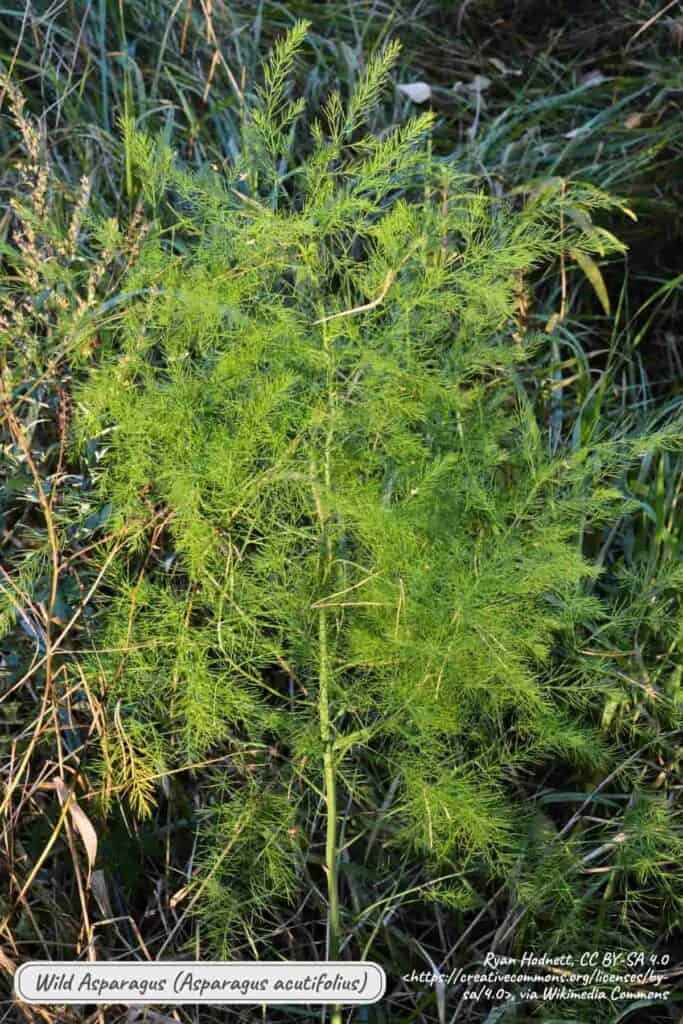
Wild asparagus is a perennial plant that is thinner than our cultivated asparagus. It has a different genetic makeup and taste than domesticated asparagus. I have never encountered it in the wild, but I sure hope to someday.
It is common in Europe, but apparently not so much in the United States. However, if you come across it, you can certainly add them raw to your pesto.
I would be more inclined to just eat them plain raw or fry them in some butter and eat them maybe with a bit of salt, but as plain as can be. Just to savor the true flavor of this more rare, and reportedly delicious, wild weed.
Here is an article about foraging for wild asparagus in Indiana, however, contrary to what the author suggests, I would not harvest them under power lines, alongside roads or anywhere where the city or utility companies mow. They normally follow up with a good dowsing of pesticides to keep the weeds from reappearing for a time. Pesticides are not something I want in my pesto!!
Watercress (Nasturtium officinale)
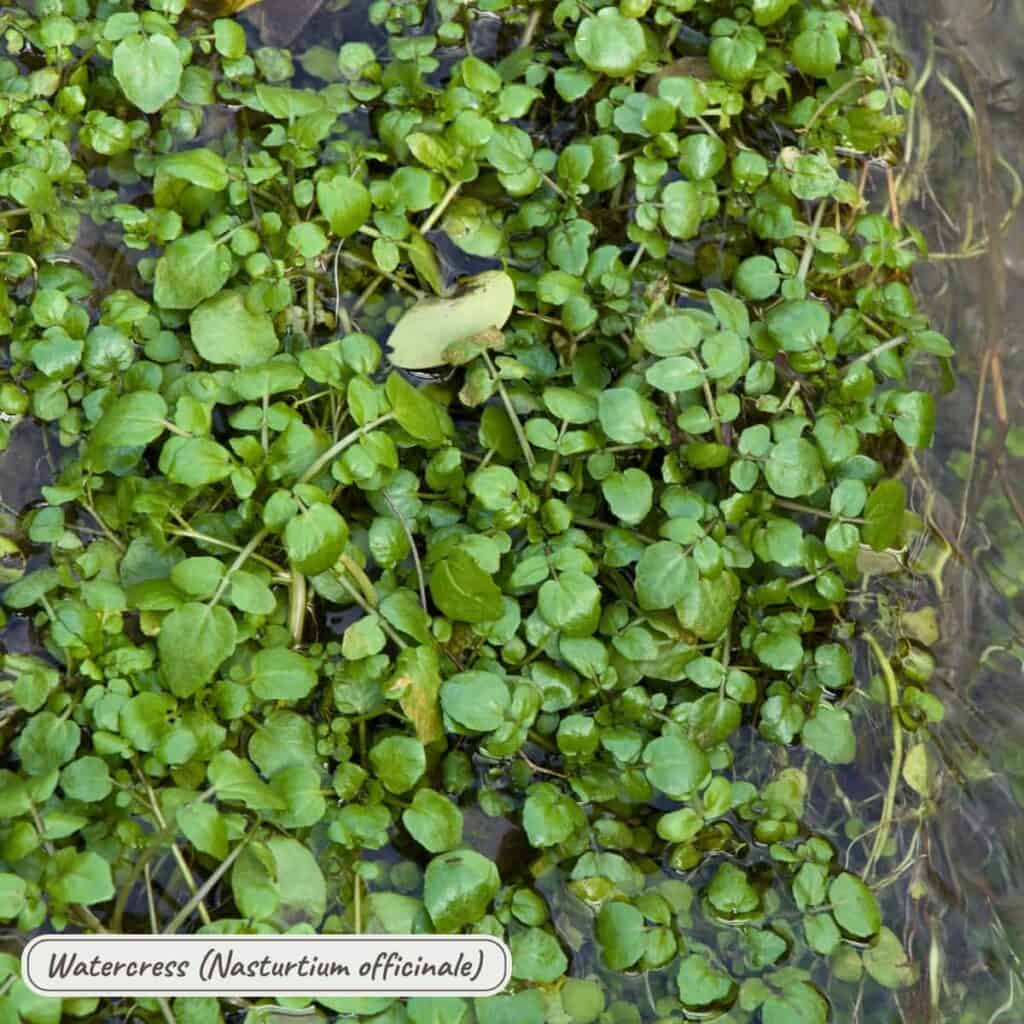
Watercress is an aquatic or semi-aquatic herb and another great favorite of mine. It is a powerhouse of nutrition. So much that it was named the world’s healthiest vegetable by the Center of Disease Control (not sure how they determine that, but it is cool that they acknowledge the benefits of a wild plant). They rated some vegetables for their ability to keep people healthy and reduce risk from chronic disease. Watercress was the only plant to earn a 100 score for its value. Oddly, garlic and blueberries didn’t make the cut.
Watercress is rich in vitamin A, C, and K, and nutrients like magnesium, calcium, copper, manganese, and potassium. It is high in carotenoids, such as lutein, beta-carotene, and glucosinolates. And it’s high in antioxidants like polyphenols and rutin. It might help with kidney, heart, and bone health, cancer, DNA damage, and asthma for starters.
It has a peppery flavor and can be eaten raw or cooked. It likes to grow in spring-fed streams, which is where I find it here, or shallow water. It should be washed before using it raw when it grows in streams, which might carry giardia, river fluke, or e-coli bacteria.
The entire plant is edible, leaves, stems, roots and flowers. And yes, I would have added the raw leaves to my pesto if I had taken the time to wander down to the creek.
Nasturtiums (Tropaeolum majus)
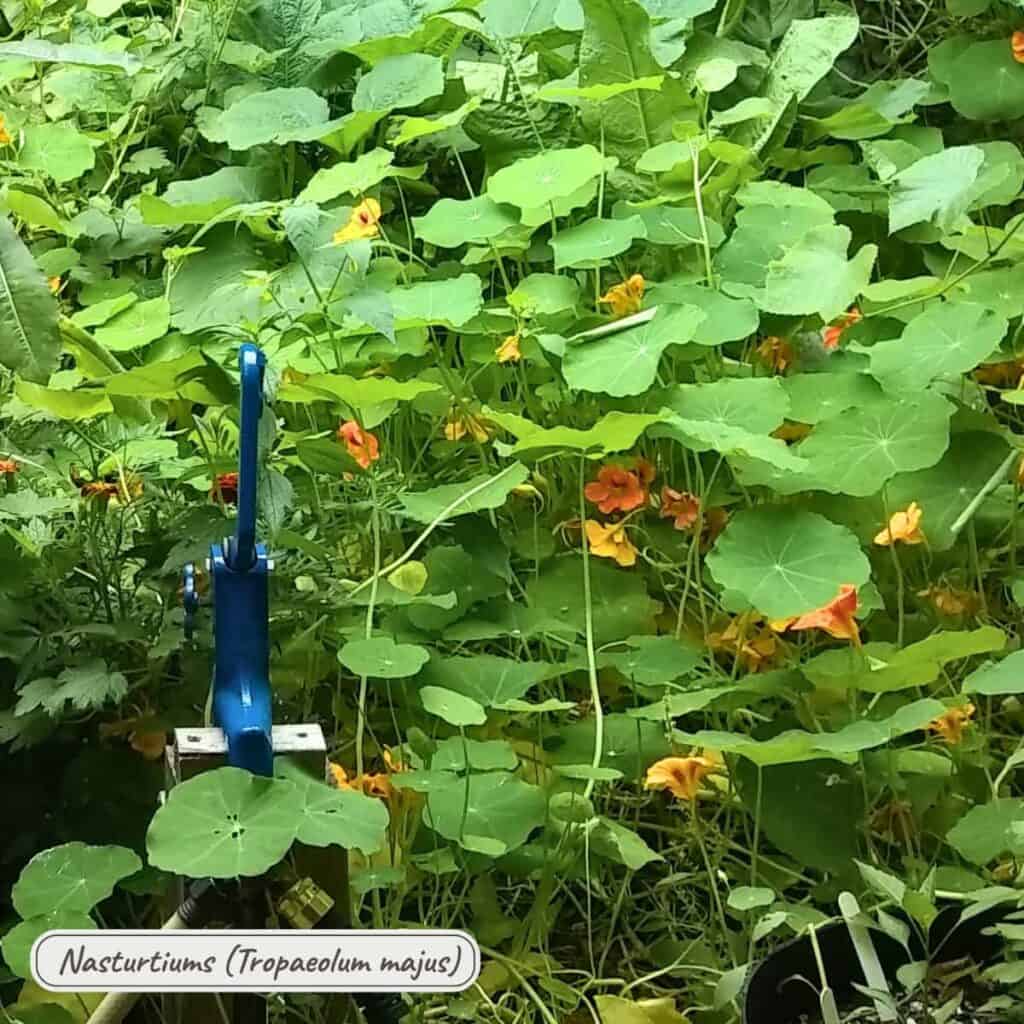
I’m mentioning nasturtiums here, because, even though they are introduced in North America and are more known for being cultivated, they have long escaped cultivation like some other weeds. And thus they are considered wild in some areas, apparently mostly in the south of the US. Apparently they are considered invasive in Hawaii (source).
They are of South American descent and are very popular in American gardens as a beautiful plant, a spice, a medicinal plant, and companion plant due to its ability to repel pests and even nematodes in the soil.
I have not encountered them in the wild, but I love them in my garden. They are full of nutrition and are the highest in Lutein content of any edible plant. I like to use the immature seed pods in soups and stir-fries or ferment them to use like capers. They can also be vinegar pickled.
The leaves and flowers are super tasty in salads and stir fries, and I’ve made a nasturtium vinegar the same way as apple cider vinegar, for a hair rinse, since they are good for the hair.
They are really great for pesto and all areal parts are edible. Once they are growing again, here in my garden, I’ll be inclined to throw a handful of the raw leaves and immature seed pods into my wild pesto and decorate it with the flowers.
Winter cress (Barbarea vulgaris)
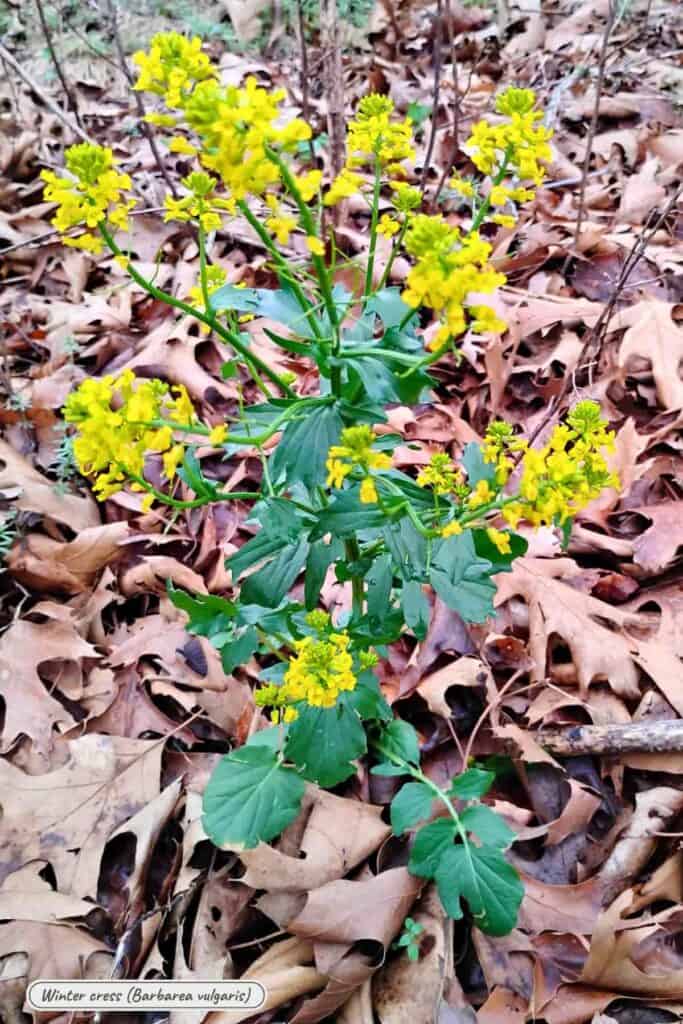
Winter cress, also known as creasy greens, upland cress, or yellow rocket, is a perennial, native of North America. Winter cress is a mustard plant in the brassicaceae family. It was used extensively for both food and medicine throughout history. Sometimes it can also act as an annual or biennial.
Wintercress is a reliable medicinal plant that has seen much use in traditional medicine. Native people used it for purifying the blood and to help with coughs. It is used to treat wounds and has digestive and diuretic properties. And it is packed full of nutrition. the arial parts are especially rich in vitamins A, C, and K, as well as calcium and fiber. They are known as an anti-scurvy plant due to their high vitamin C content.
The young leaves can be used in salads to add a zesty, peppery kick, while older ones can be added in soups. The buds can be eaten like broccoli and the seeds can be sprouted to use in salads or on sandwiches.
I found some winter cress in the woods beside my pasture but it has gone to flower already so I left it. However I’m planning to go back for the seeds later this season so I can spread some in my food forest up here on the hill.
But I would totally add raw winter cress leaves or buds of the winter cress to my pesto if I had caught it a little sooner.
Garlic Mustard (Alliaria petiolata)
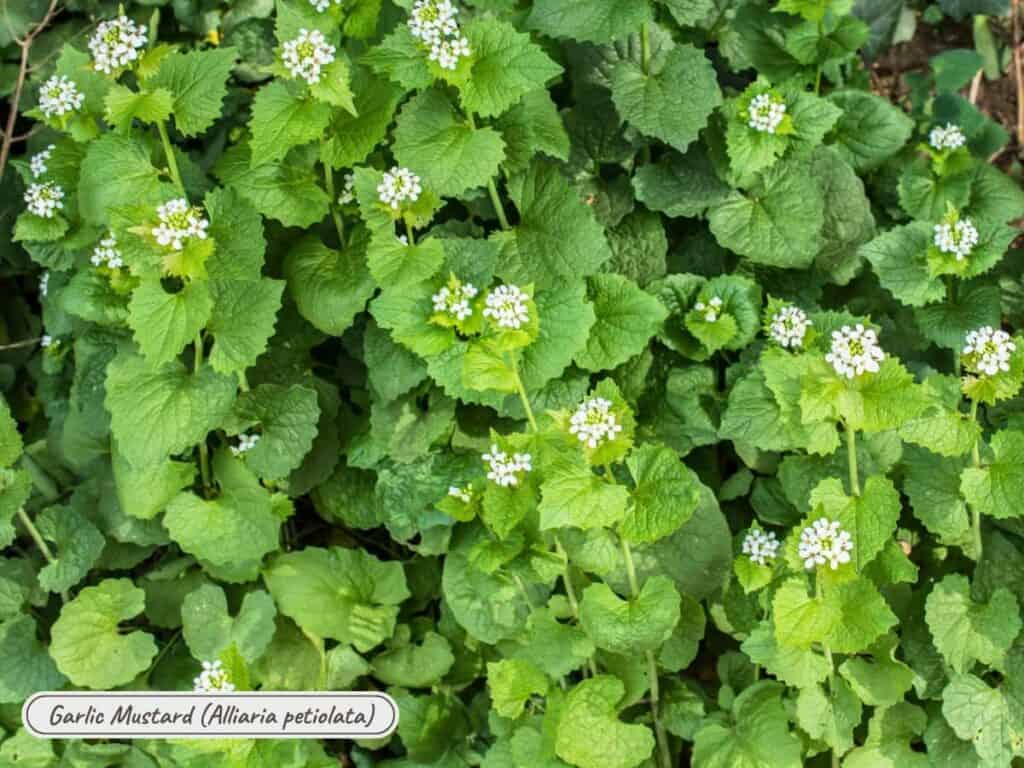
Garlic mustard is considered an invasive weed. But it is edible. Its leaves emit a garlic scent, which is where this mustard gets its name. It has allelopathic compounds that can inhibit the growth of other plants in its vicinity, which poses a great ecological threat.
So garlic mustard is not one you need to feel bad about over harvesting! It is threatening biodiversity in areas where it becomes established. Once it gets started it can dominate the area in just 5-7 years. This is not a plant that I want to introduce into my ecosystem here.
Garlic mustard is a good source of vitamins A, C, and E, minerals such as calcium, iron, manganese and zinc, and omega-3 fatty acids. Medicinally it has antiseptic and diuretic properties and might improve heart health, lower cholesterol and strengthen the immune system.
Older garlic mustard should be cooked because it develops cyanide, but the younger leaves can be used in raw dishes, such as pesto. And the roots can be used as well, it is compared with horseradish according to one source.
If I had to get rid of garlic mustard, I’d be using it in my pesto and make medicine. But I’d also follow the protocol outlined by the nature conservancy to remove extra plants, roots and all, and try to help the native plants grow back once again.
Japanese knotweed (Reynoutria japonica) (also called Polygonum cuspidatum or Fallopia japonica)
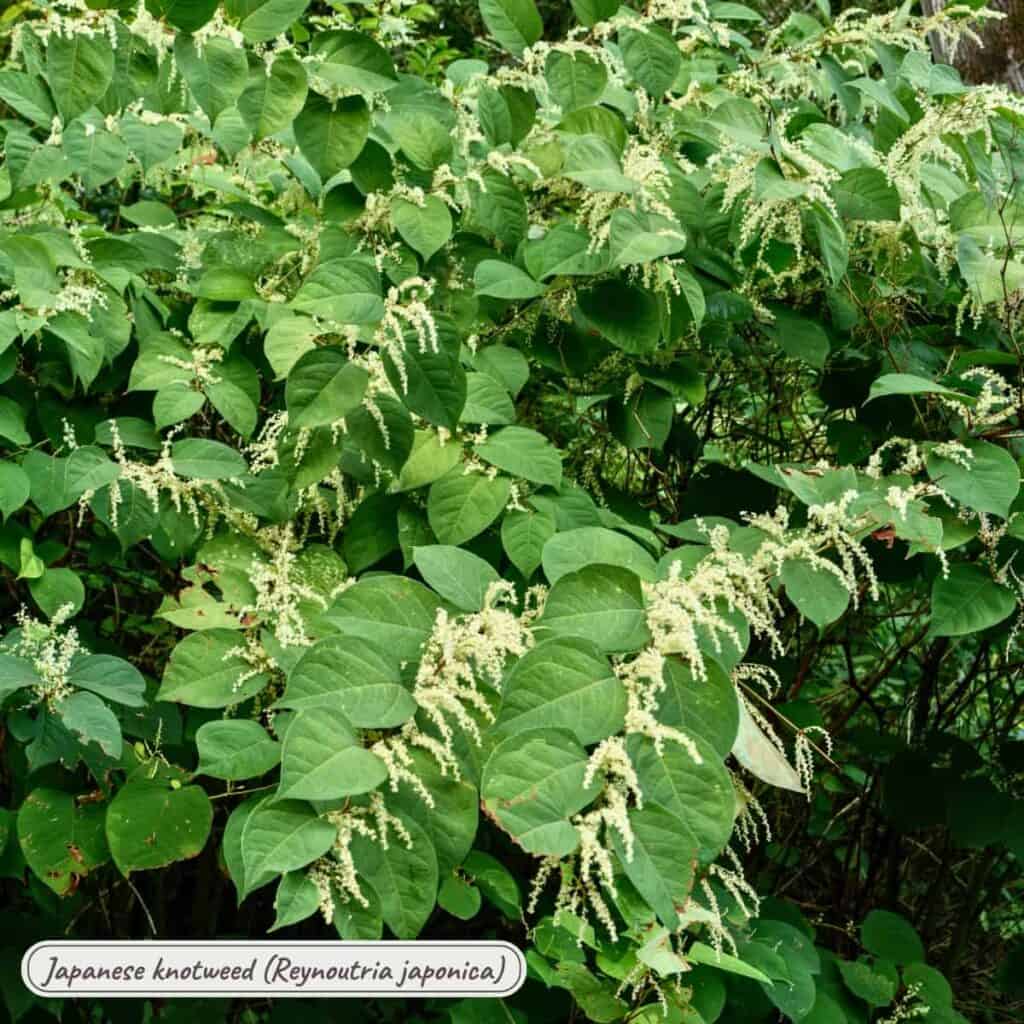
Oh no, not Japanese knotweed! Have you encountered it? Man, that one can be a brutal nuisance for some people. I heard of the rhizomes digging themselves under houses, ruining foundations, and breaking right through concrete.
Here is a great article about Japanese knotweed if you care to learn more about it. I don’t think that they found a way to control it yet, but if it has invaded your yard, you might as well be eating it.
Japanese knotweed is an introduced weed, and as much as we hate it otherwise, it can offer us good nutrition and tasty treats. In recipes it can be used like rhubarb. The shoots, peeled stems, and roots are edible raw or cooked. It’s a good source of Vitamin A, vitamin C, resveratrol, potassium, phosphorus, zinc, and manganese. However it also contains oxalic acid and so it should be eaten in moderation.
I did cook with Japanese knotweed back in Washington, where it grew rampant in my area, and yes, in my pasture. The goats loved it! Be aware that you must take care not to spread it if you bring it home. It can start growing from tiny scraps of the stem or root, that are carelessly flung on the ground.
And yes, I would add the shoots raw to my pesto if it grew here, but I sure don’t miss having japanese knotweed around!
Claytonia (Claytonia perfoliata) or (Claytonia virginica)
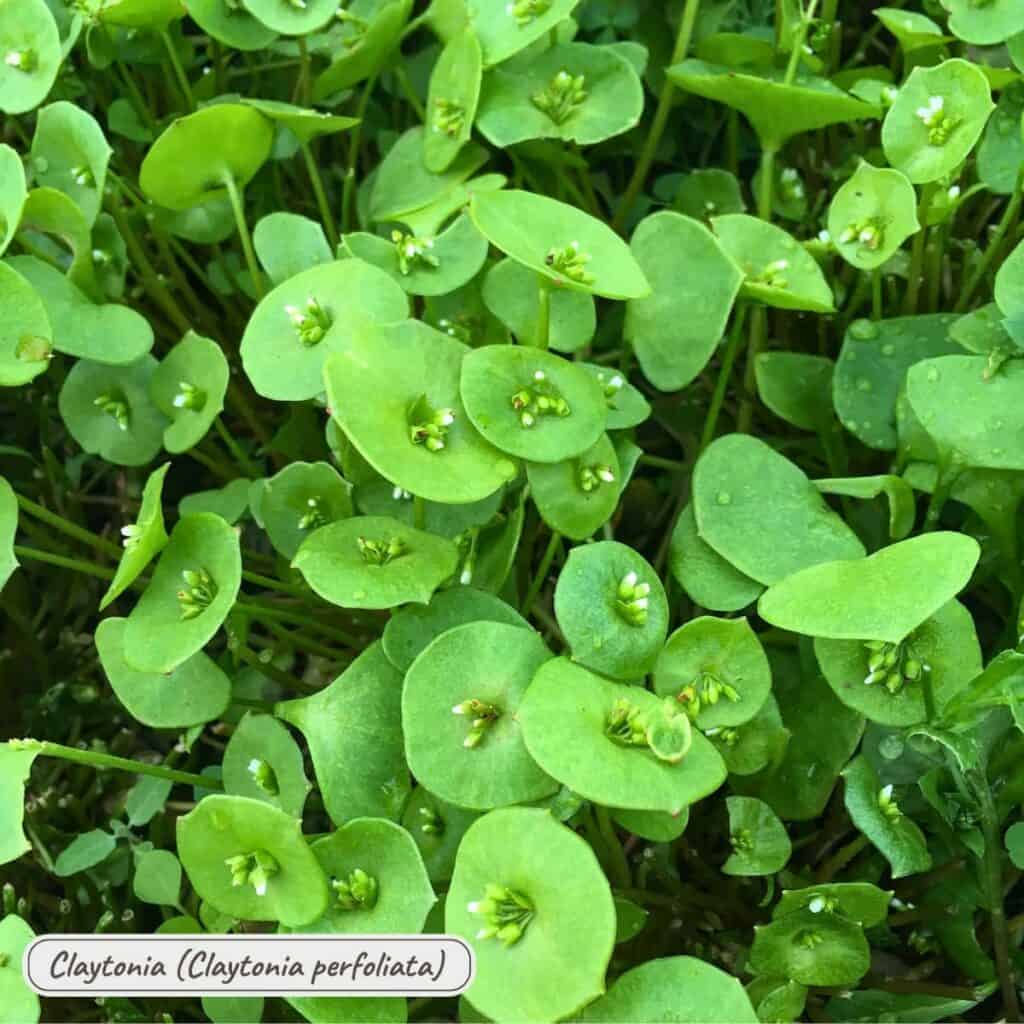
Claytonia, winter purslane, miner’s lettuce, or spring beauty is a North American native, and while the C. perfoliata is mostly found in the coastal areas and the Western mountains, C.virginica is home to the Eastern and Midwestern states.
Claytonia is a mild herb with a bright flavor and a succulent texture. It is aparently a bit like purslane. C. perfoliata is often cultivated in gardens as a winter green. In areas of hard frost, it can be grown in hoop houses for winter greens. Read more about Claytonia here.
Claytonia is a good source of Vitamin A and C, iron and calcium. I haven’t found it yet in the wild (sad face), but I’m thinking of growing it in my garden from seed.
I heard that it is great for pesto and I would add the raw claytonia leaves and stems to my pesto if I found them.
Cleavers (Galium aparine)
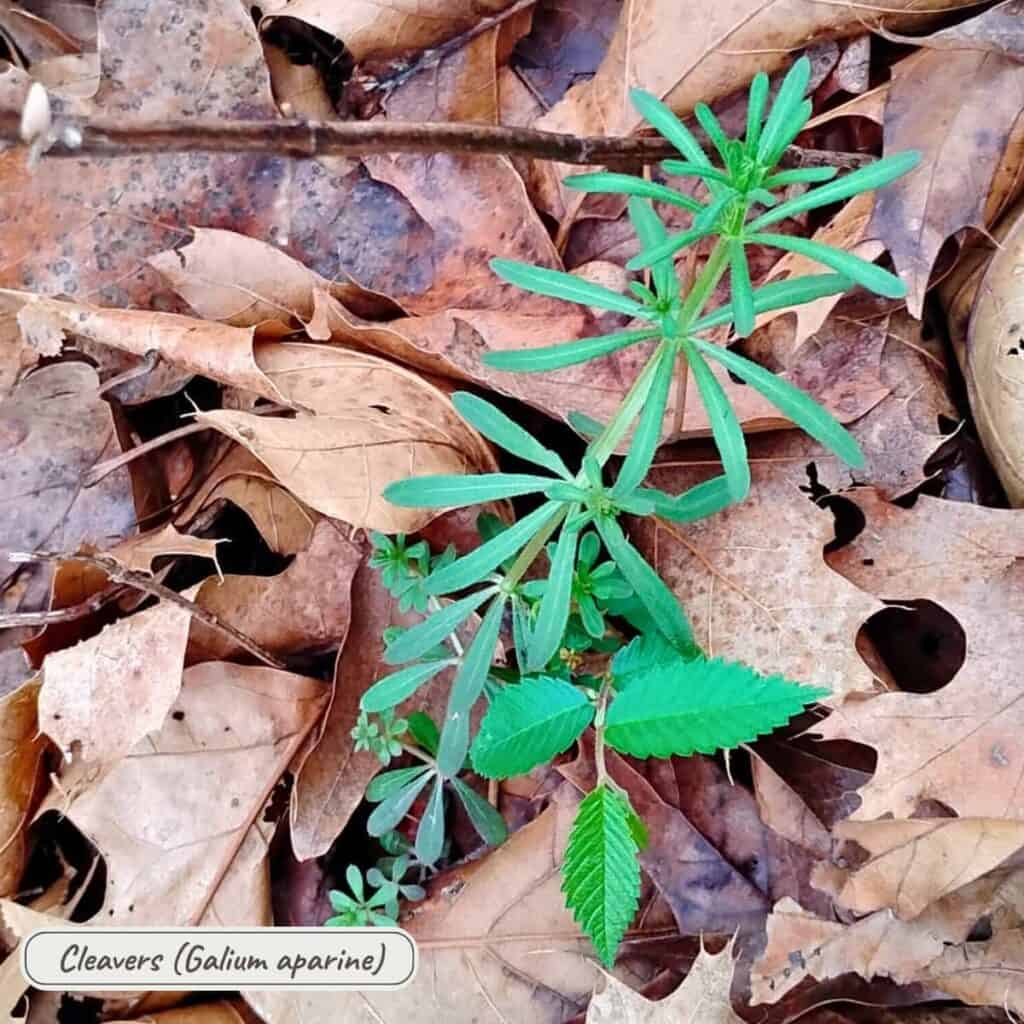
Cleavers or bedstraw, love to cling to things. They are a dainty plant that develops sticky hairs to help itself grow taller by attaching itself to taller plants. I did find a sprig of it in the woods behind the pasture just a few days ago, and am planning to go back to see if I can find more. It grew with abundance in Washington.
The cleavers have been used in folk medicine to reduce swelling, boost energy, for skin health, and to treat infections. Cleavers are regarded for their ability to support the lymphatic system. It is a diuretic, is thought to support liver function, is anti-inflammatory and antioxidant, and is one of the best cleansing tonics. Read more about medicinal properties here.
Here is a great article about cleavers and traditional uses such as making a coffee substitute from the seeds and dyes from the root. Cleavers are in the madder family, and the same family as coffee (Rubiaceae). It has also been used in place of rennet for curdling milk to make cheese.
Nutritionally it is high in vitamins A, C, E, and K, and rich in minerals such as magnesium, calcium, and potassium.
I would certainly use cleavers in pesto, but to tame the sticky hairs, I’d blanch or steam it first for 1-2 minutes before adding it to the pesto mix.
A Few Others To Consider
Cattails (Typha latifolia) This grows abundantly in a swampy area around my pond. But I’m not sure how clean the water is, since some neighbors tend to spray pesticides in their pasture. Something to consider whenever you want to forage cattails.
Bluejacket or Ohio Spiderwort (Tradescantia ohiensis) I just found this one a couple of days ago in my driveway and have yet to find out more about it. I’ll update this if I find that it works well for pesto.
Mouse eared Chickweed (Cerastium vulgatum) I have lots of it growing in my pasture. This one has hairy leaves but flowers like stellaria medium. Apparently, it can also be added to pesto, but should be cooked first. I’ll be experimenting with it, since I have so much of it. But I don’t know if I’ll like it as much as stellaria. We’ll see.
My Favorite Literature for Plant Id and Foraging
The Forager’s Harvest, Samuel Thayer
Healing Wise, Susun Weed
A Dandelion Celebration, Peter Gail
Edible Wild Plants, Peterson Field Guides
Nature’s Garden, Samuel Thayer
For The East
Field Guide to North American Wildflowers, National Audubon Society
for the Midwest
Here is one I don’t own, but it’s on my wishlist
Midwest Medicinal Plants, Lisa Rose
For the West Coast
Northwest Foraging, Doug Benoliel
Wildflowers of the Pacific Northwest, Mark Turner and Phyllis Gustafson
Plants of the Pacific Northwest Coast, Pojar and Mackinnon
Pacific Northwest Medicinal Plants, Scott Kloos
Wild Greens Pesto Recipe
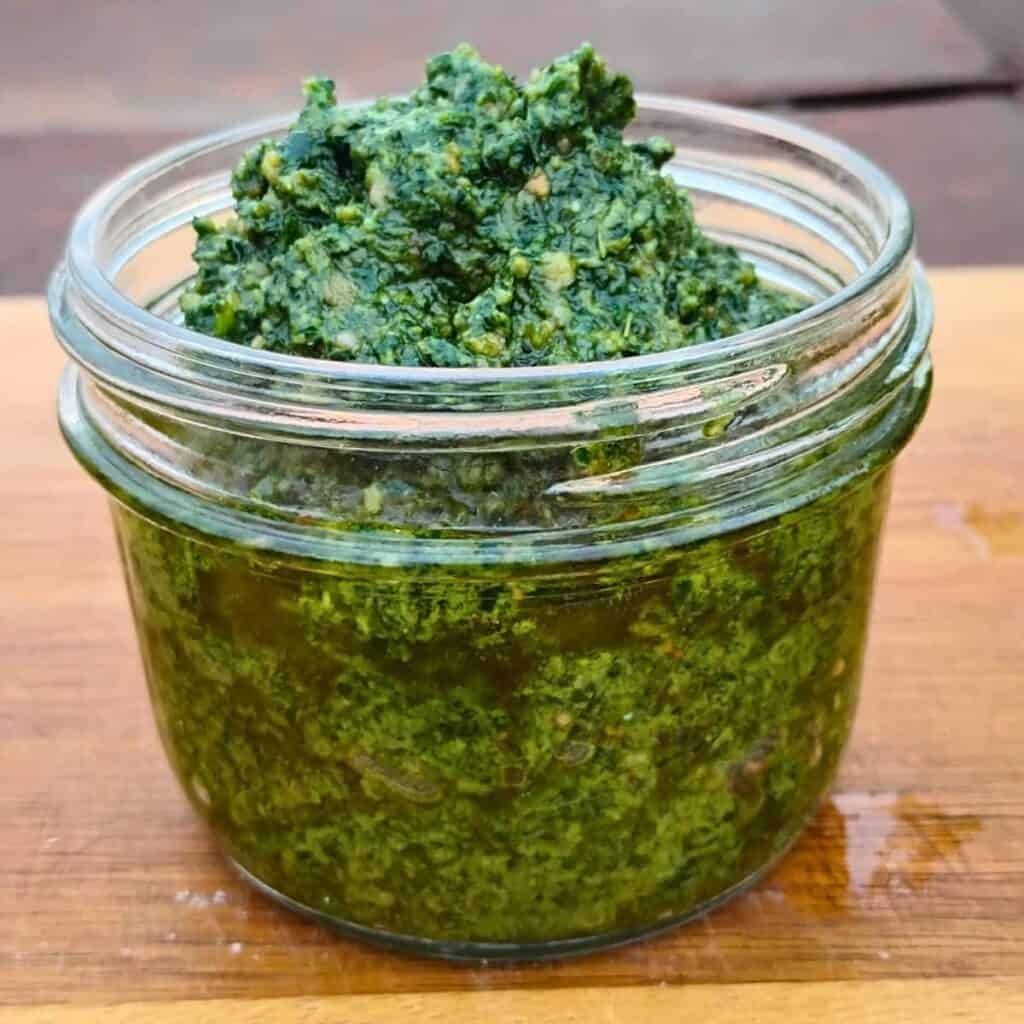
Now that we have lots of wild greens to choose from, let’s make some pesto!
Equipment
Food Processor – We’ll use a food processor for blending all the ingredients to make our delicious pesto!
Spatula – I use a Silicone spatula for scraping the sides of the processor a few times during processing, and to get every last bit out at the end.
Storage Jar – Use any jars you have at home. I like to use 16 oz, wide mouth canning jars or the squat shaped 8 oz jars.
Ingredients
Summary of The Greens
Stinging Nettles (Urtica dioica)
Purple Dead Nettle, (Lamium purpureum)
Plantain, broad leaf, (Plantago major) or narrow leaf (Plantago lanceolata)
Clover, white (Trifolium repens) or red (Trifolium pratense)
Violets (Viola)
Common Milkweed (Asclepias syriaca)
Purslane (Portulaca oleracea)
Sorrel (Rumex acetosa), Sheep Sorrel (Rumex acetosella), Wood Sorrel (Oxalis)
Henbit (Lamium amplexicaule).
Ground Ivy (Glechoma hederacea)
Dandelion (Taraxacum officinale)
Lambs Quarters (Chenopodium album)
Chickweed (Stellaria media)
Wild Garlic Grass (Allium vineale) or Wild Onion Grass (A. canadense)
Ramps (Allium tricoccum)
Wild Asparagus (Asparagus acutifolius)
Watercress (Nasturtium officinale)
Winter cress (Barbarea vulgaris)
Garlic Mustard (Alliaria petiolata)
Japanese knotweed (Reynoutria japonica)
Claytonia (Claytonia perfoliata) or (Claytonia virginica)
Cleavers (Galium aparine)
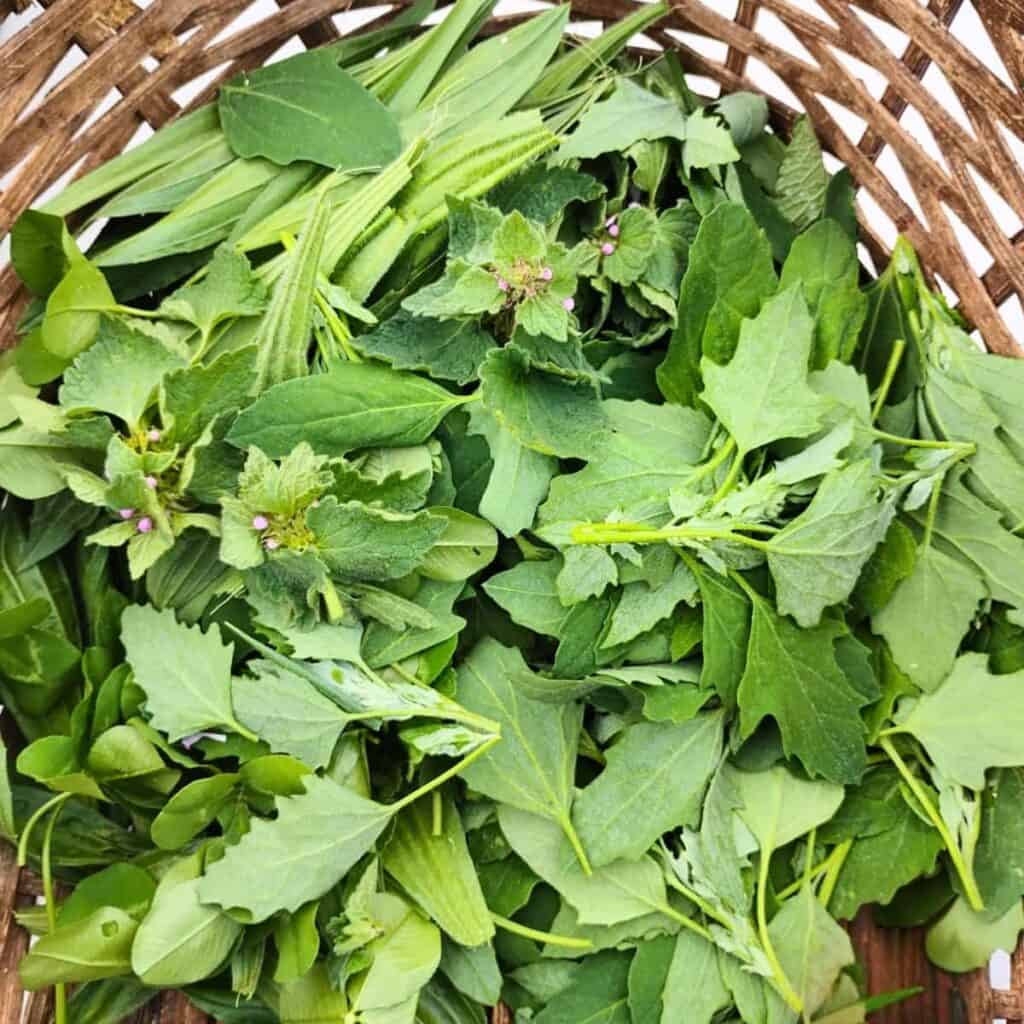
6 cups of wild greens – choose a combination or just a single one. Here is the mix I made today, that I absolutely adore. I used about equal parts purple dead nettle leaves and tops and lambs quarters for about ¾ of my mix. Then I added in a few sprigs of red clover leaves, and plantain leaves to make up the 6 cups.
Sunflower seeds – Or pumpkin seeds, hazelnuts, pecans, walnuts, hemp seeds, or pine nuts.

Pecorino Romano, Asiago, or Parmesan cheese – Any hard, strong flavored cheese will work. I actually used my 3 year old aged goat cheddar cheese that has become a bit dry and tastes a lot like romano after all these years.
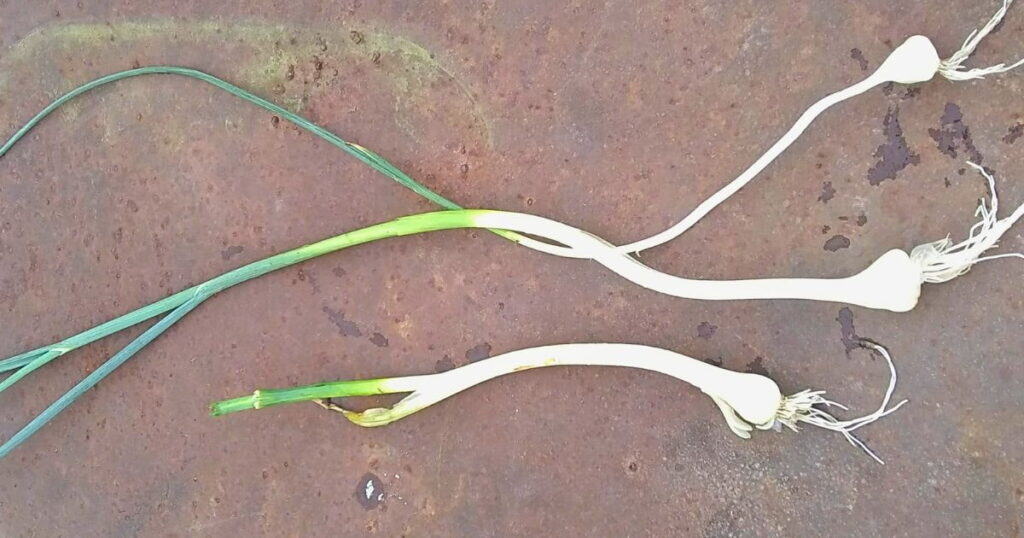
Wild garlic cloves and leaves, or garden garlic cloves. Garlic scapes work great too!!
Olive oil – I prefer organic extra virgin, high quality olive oil for the best pesto.
Unrefined Sea Salt – I recommend Redmond’s Real salt, Himalayan pink salt, Celtic sea salt or other unrefined, pure sea salt. Of course, you can use any salt if that is what you have.
Instructions For Making Foraged Wild Greens Pesto
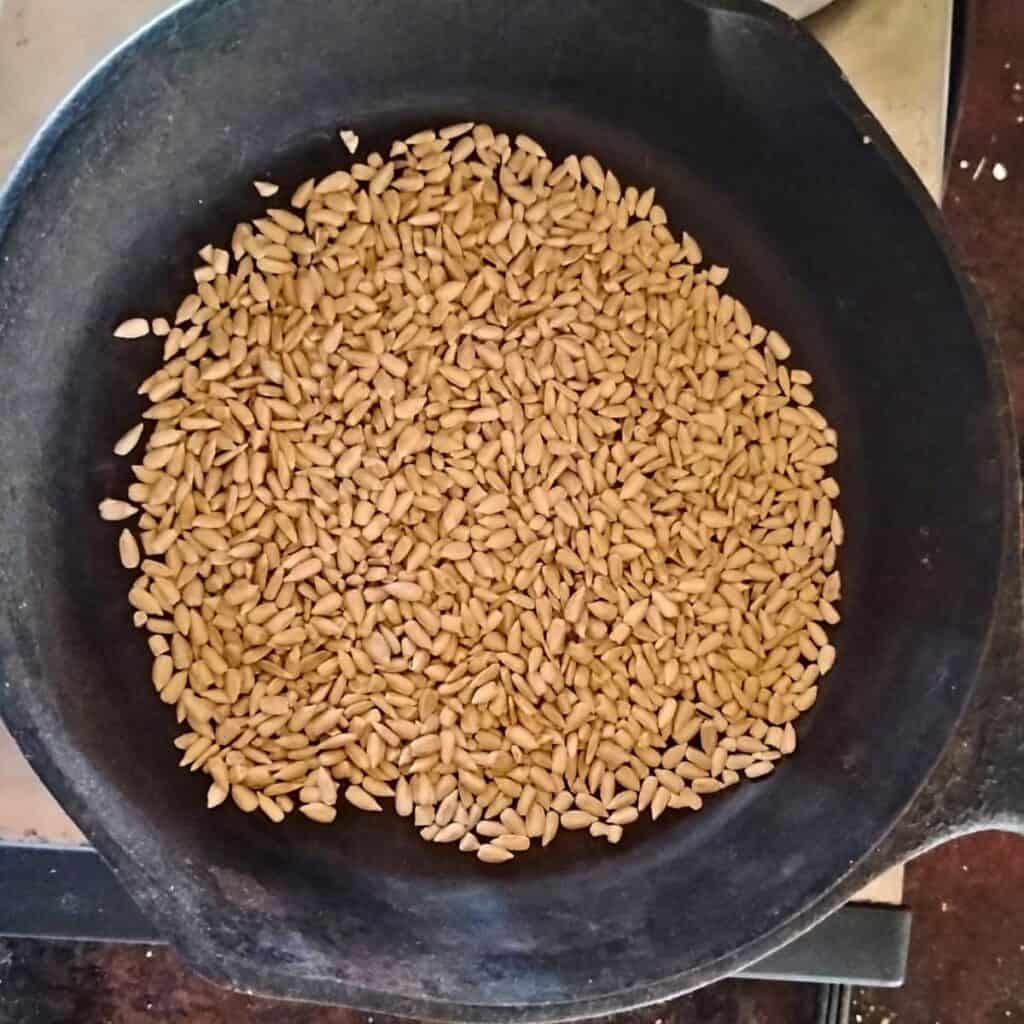
Place the seeds or chopped nuts in a pan and toast them on medium. Do watch them like a hog. They get over toasted really quick once they get hot.
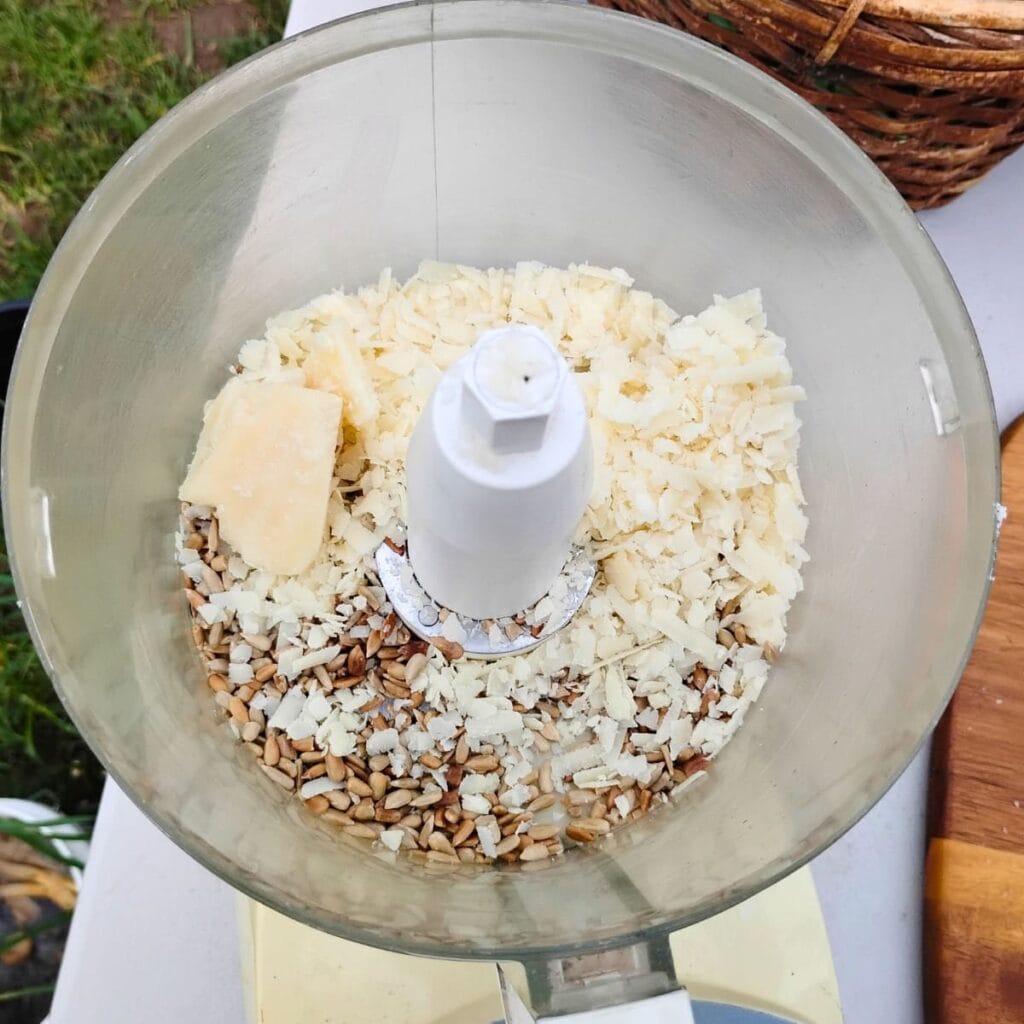
Place the seeds into the food processor bowl. When they are completely cooled, add the chopped or grated cheese and garlic.
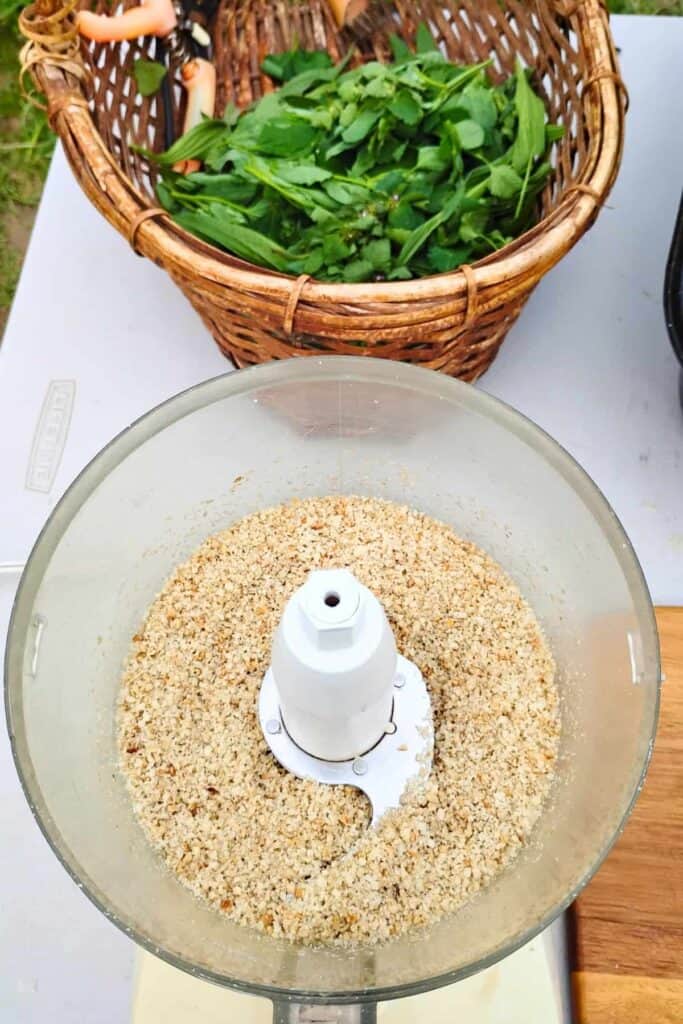
Process into crumbs. Then add the greens. I had to add half and then add more after the first half was chopped up.
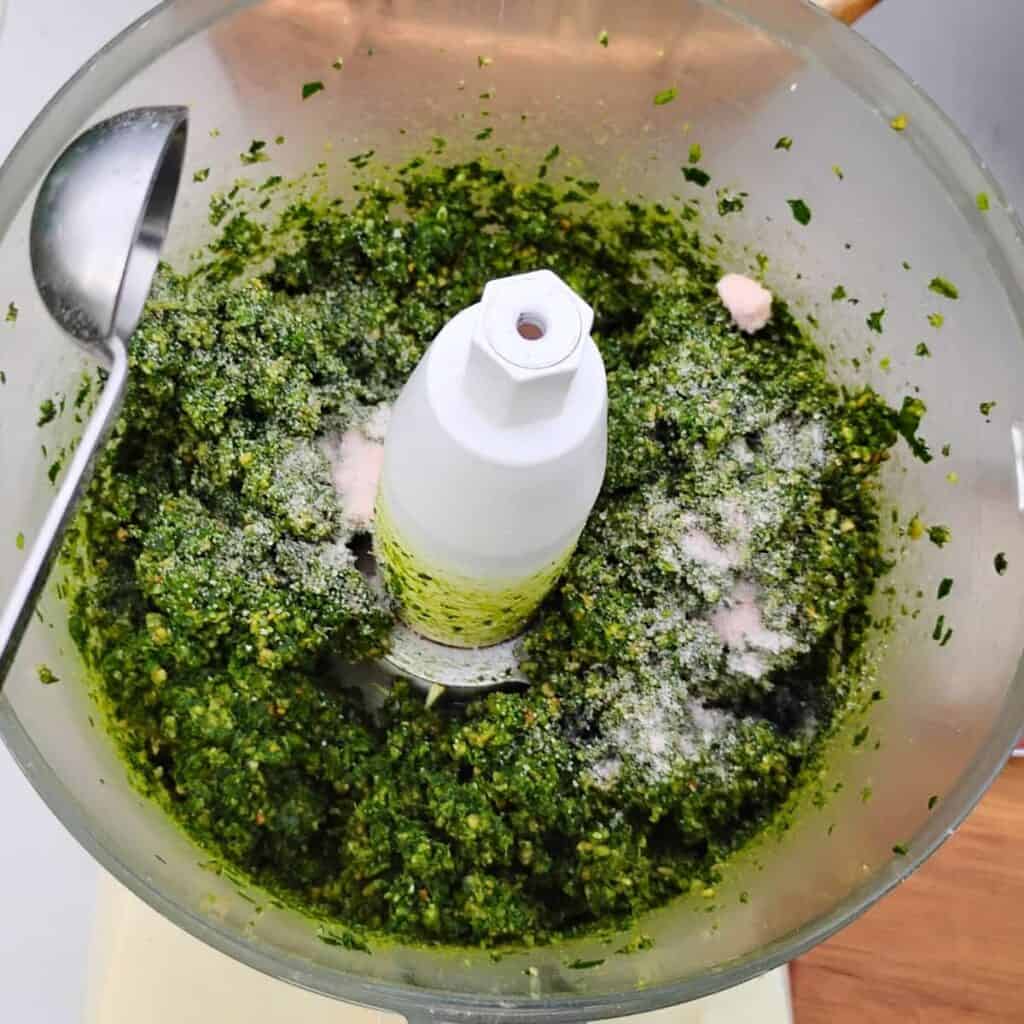
Once you have a pasty consistency, add the salt. Start with ½ teaspoon, then adjust after you’re finished.
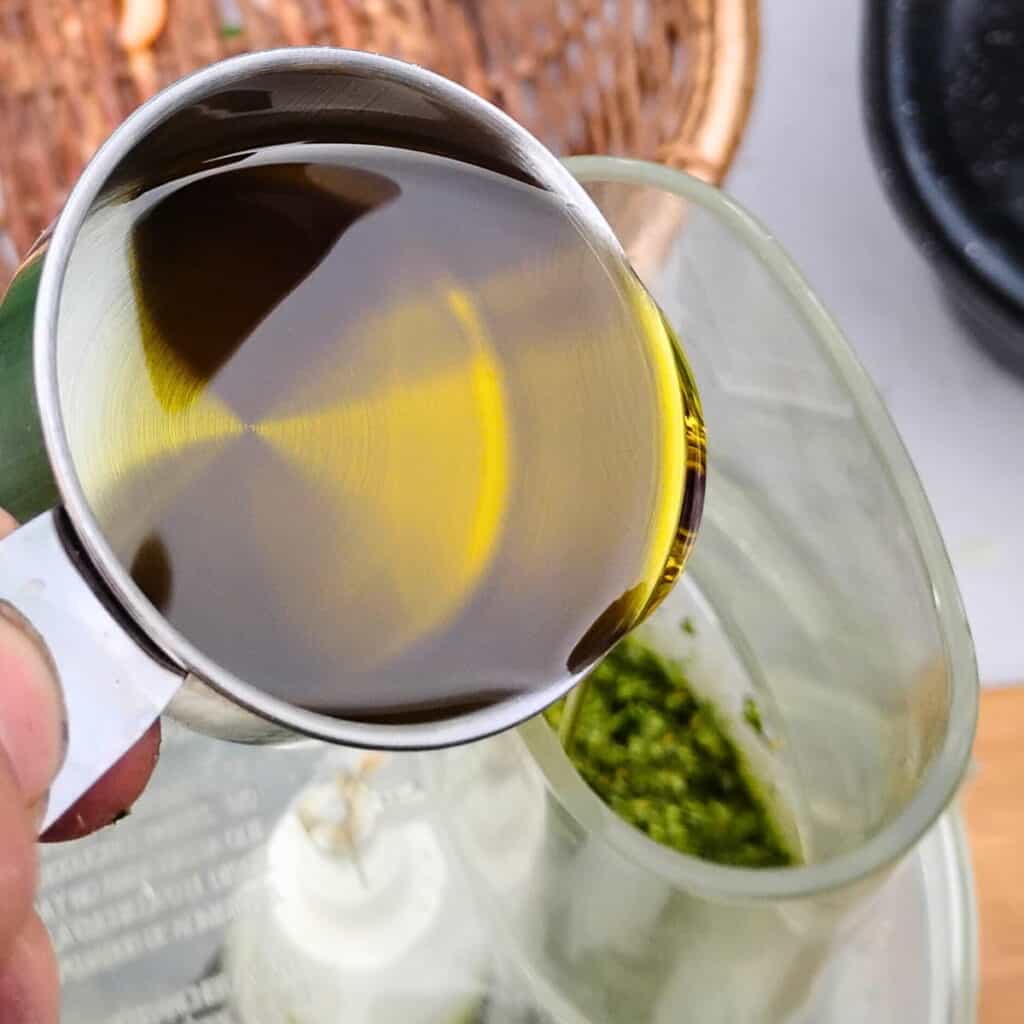
While the processor runs, drizzle in the olive oil. Taste and adjust saltiness if desired.
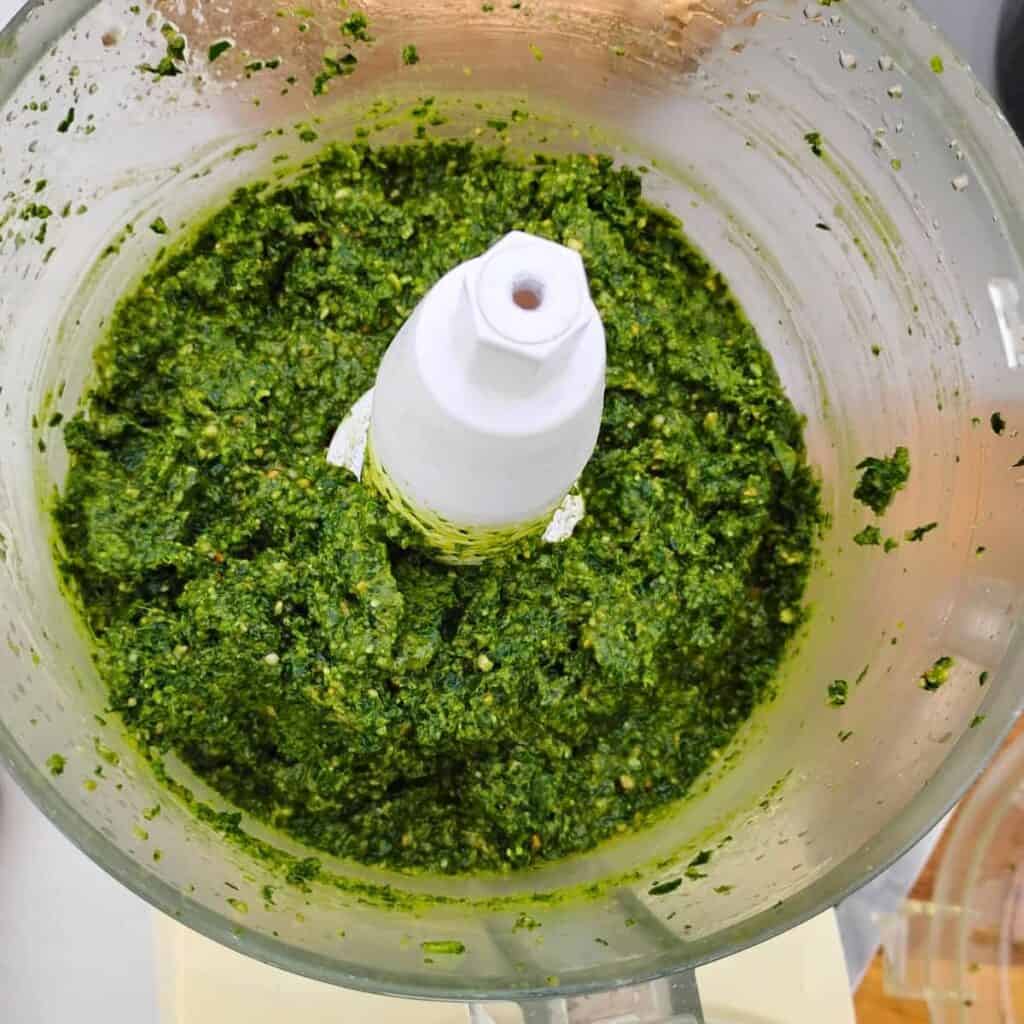
Store the pesto in a glass jar for up to a week. To prevent oxidation and browning, you can drizzle a thin layer of olive oil over the top.
How To Use The Pesto
I’m warning you, this is so delicious, you’ll want to top everything with it.
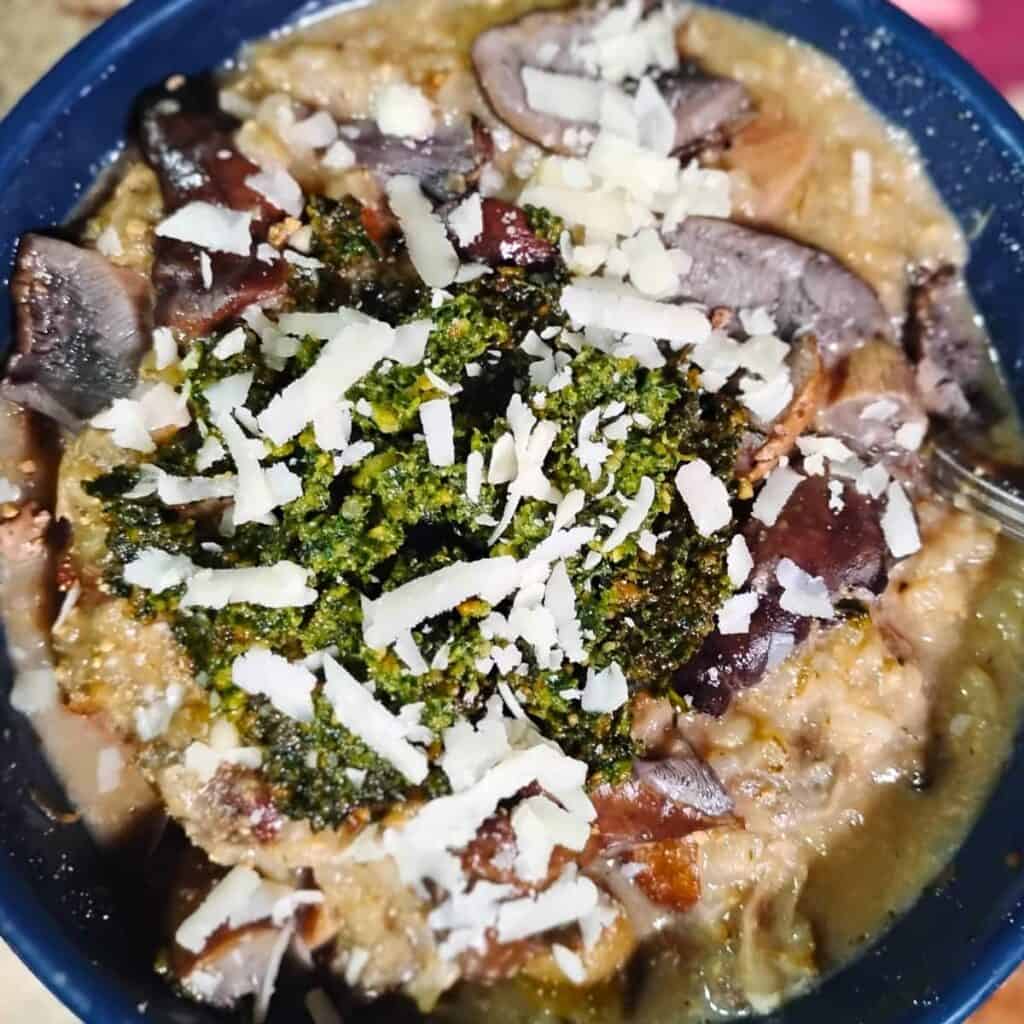
I made some home grown mushroom risotto (I’ll share the recipe soon, it’s awesome!), and it tastes so amazing with some of this pesto.
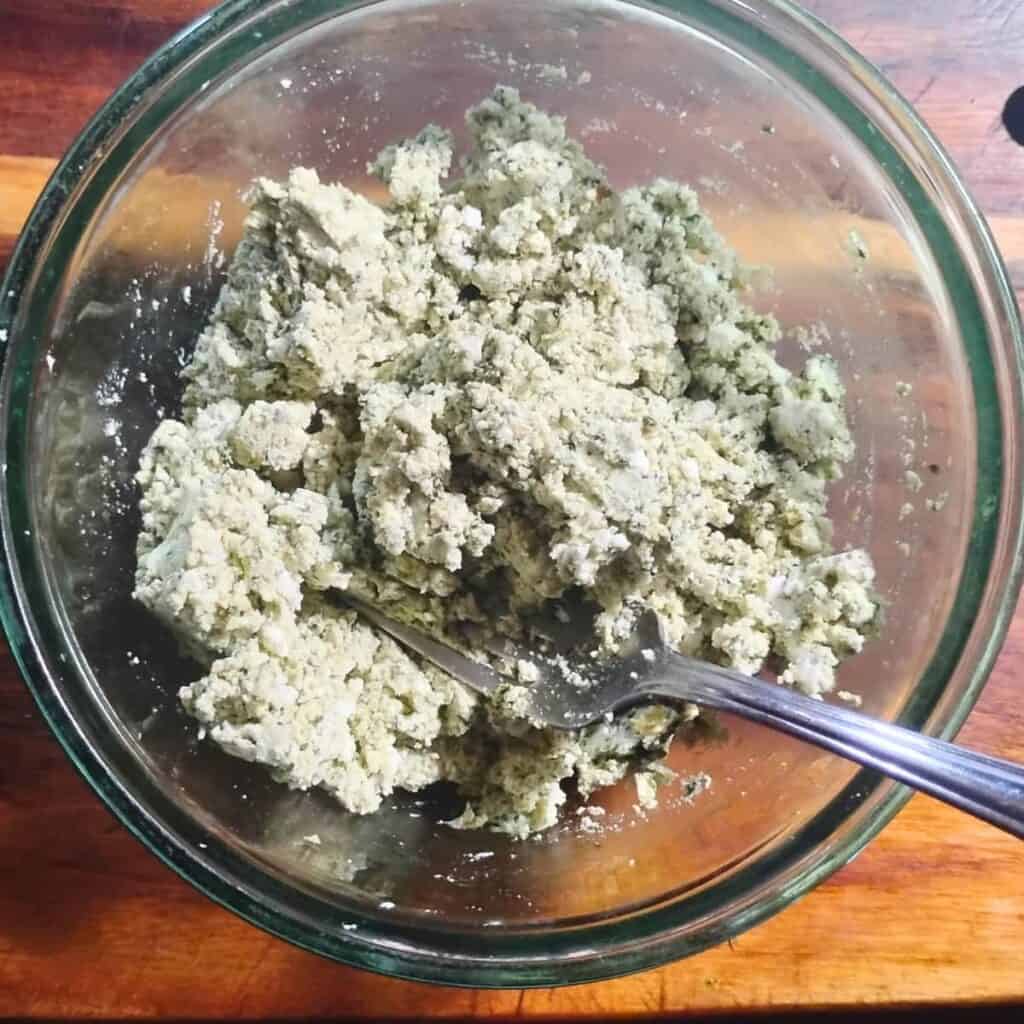
Then I mixed some fresh made Chevre with this pesto and added a little canteloupe hot sauce and it makes an amazing bread spread that’s even better topped with my pasture raised chicken eggs (medium over!!). I’ve been eating this every morning for several days, it’s just super tasty!!

It would be amazing on some fish or goat chops, pork roast, or wild meat like venison. Wild meats love wild weeds! Both have robust flavors that support each other.
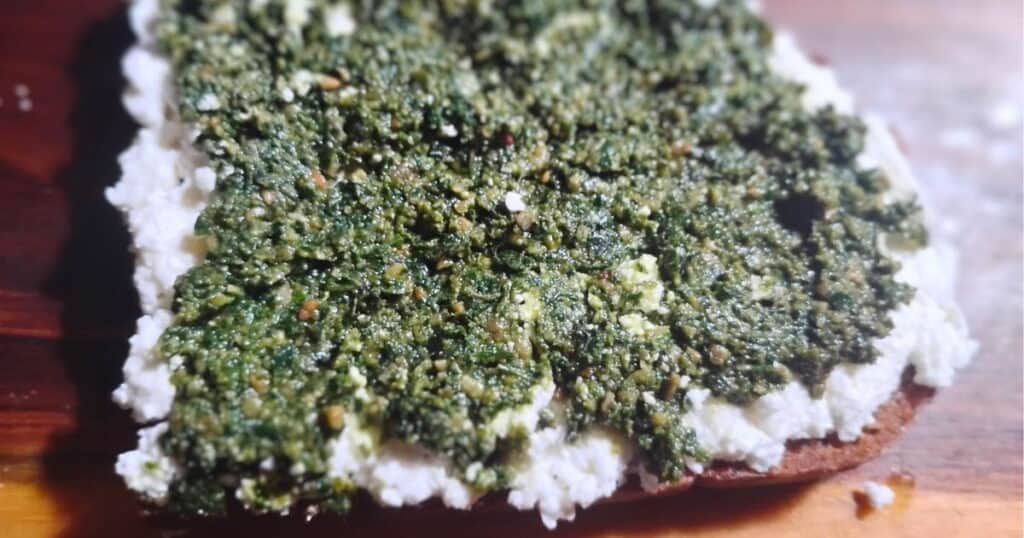
I love it as a topping on sourdough bread with fresh made clabber cheese or Quark.
And of course you can use pesto on anything you use the old basil pesto for. The flavor will be different, but therein lies its character. Mix into Pasta or rice,
Serve as a condiment on a cheese platter.
Make a Pesto Pizza.
Use in Pasta salad, potato salad, deviled eggs, omelettes, or sandwiches. It’s great too in hot sandwiches!
How Can I Preserve The Pesto?
Pesto is easy to preserve. It keeps for a week in the refrigerator. For longer term, you can freeze it.
Freeze in batches in containers or in ice cube trays for single portions. The oil content will help keep it from deteriorating quickly. It should last for 6 months or more in the freezer, especially if you vacuum seal it after it’s frozen. Defrost in the refrigerator and keep it refrigerated at all times when it’s not in use.
Enjoy Your Foraged Wild Greens Pesto!

I hope you love this pesto as much as I do. Of course, it will taste different depending on what greens you choose, but I’ve made it with primarily chickweed in the past and it was delicious, I made it with a mix of wild and domesticated greens and that too was delicious, and this latest one was very different, but also delicious. So if you start with delicious, fresh picked greens, it should turn out great! And it will be very nutritious, because generally, wild greens are loaded with vitamins, minerals and health benefits.
Let me know in the comments below how you like this wild greens pesto and what your favorite wild greens are. You can also ask me your questions there. And if there is anything you’d like to read about, I appreciate your suggestions.
To get more recipes like this and other information on homesteading and traditional skills, sign up for my Food For Life Garden News, and I’ll let you know when I post new information.
More Content Like This
Mushroom Risotto – delicious gourmet flavored rice dish that’s easy to make and it’s a perfect way to highlight the flavor of mushrooms.
Forage Purple Dead Nettle And Make A Tincture – Capture the many health benefits of purple dead nettles in a tincture for year round use.
Recipes for Garlic Scapes and Bolted Onion Greens – There is much you can do with garlic scapes and bolted onions. I’m sharing my favorite ways to use them and how to make a delicious pesto sauce.
How To Grow Garlic – What to do to get big and healthy garlic bulbs. When and how to plant and harvest.
25 Essential Herbs To Plant – Start your home apothecary garden with these 25 powerful allies for your health. Learn their benefits, how to grow them and where to source them.
Grow mushrooms at home in your garden This is one of the most rewarding experiences in wood chip gardening. Grow your own mushrooms intentionally. It’s easy and they taste so delicious!
Plant a Tree Guild, Grow A Food Forest – How to grow a food forest starting from scratch with a tree guild. Grow a lively ecosystem for your trees!
Make your own chevre cheese from scratch – How to make super versatile creamy, spreadable cheese that can be used as a dip, or spread, for baking, for savory or sweet shakes, fresh or aged. Replace store bought cream cheese with this healthy version!
Bonny clabber – What is clabber milk and its uses Learn to make bonnyclabber, the original cheese. This is nature’s way of preserving milk. I love turning it into a tasty kind of cream cheese that makes a really good frosting for einkorn zucchini bread and other sweet breads.
Natural cheese making process – Make your own mesophilic and thermophilic cheese starter and use it to make cheese the natural way. You can also make yogurt from scratch with your own homemade starter too.
Queso Fresco cheese recipe – The quickest, easiest cheese you’ll ever make and so versatile!
Homemade Apple Cider Vinegar – This lovely vinegar is made from apple scraps, not the actual apple cider. But it is just as effective, easier to make and uses all those leftover apple scraps or ugly apples.
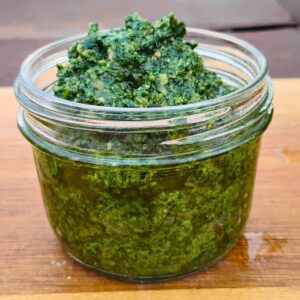
Wild Greens Pesto Recipe
Equipment
- Food processor
- Spatula
- Storage Jar – To store your pesto for later.
- Frying Pan
Ingredients
- ½ cup sunflower seeds – Or pumpkin seeds, hazelnuts, pecans, walnuts, hemp seeds or pine nuts
- ¾ cups Pecorino Romano, Asiago, or Parmesan cheese – Any hard, strong flavored cheese will work. I actually used my 3 year old aged goat cheddar cheese that has become a bit dry and tastes a lot like romano.
- 4 garlic cloves, wild garlic, or garlic scapes to taste
- 6 cups of foraged wild greens
- ¾ cup Olive Oil – Best is a quality extra virgin organic olive oil.
- ½-1 tsp Sea Salt
Instructions
- Place the seeds or chopped nuts in a pan and toast them on medium. Do watch them like a hog. They get over toasted really quick once they get hot.
- Place the seeds into the food processor bowl. When they are completely cooled, add the chopped or grated cheese and garlic cloves. Process into a paste. Add the greens. I had to add half and then add more after the first half was chopped up.
- Once you have a pasty consistency, add the salt (I’d start with ½ teaspoon, then adjust after you’re finished.
- While the processor runs, drizzle in the olive oil. Taste and adjust saltiness if desired.
- Store the pesto in a glass jar for up to a week. To prevent oxidation and browning, you can drizzle a thin layer of olive oil over the top.
Uses For Pesto
- I'm warning you, this is so delicious, you'll want to top everything with it. I made some home grown mushroom risotto (I'll share the recipe soon, it's awesome!), and it tastes so amazing, especially when topped with some of this pesto.
- I love spreading the pesto on sourdough sandwiches. It's great with clabber cheese or on chevre.
- Then I mixed some fresh made Chevre with this pesto and added a little canteloupe hot sauce and it makes an amazing bread spread that's even better topped with some fried, pasture raised chicken eggs (over medium!!). I've been eating this every morning for several days, it's just super tasty!!
- It would be amazing on some white fish or salmon, or with goat chops, pork roast, or wild meat like venison. Wild meats love wild weeds! Both have robust flavors that support each other.
- And of course you can use pesto on anything you use the old basil pesto for. The flavor will be different, but therein lies its charm.
- Mix into Pasta or rice, or serve as a condiment on a cheese platter.
- Use in Pasta salad, potato salad, deviled eggs, omelettes, or sandwiches. It’s great too in hot sandwiches!
- Here is the combination that I used today and I absolutely adore. I used about equal parts purple dead nettle leaves and tops and lambs quarters for about ¾ of my mix. Then I added in a few sprigs of red clover leaves, and a good amount of plantain leaves.
Notes
Pin This Post
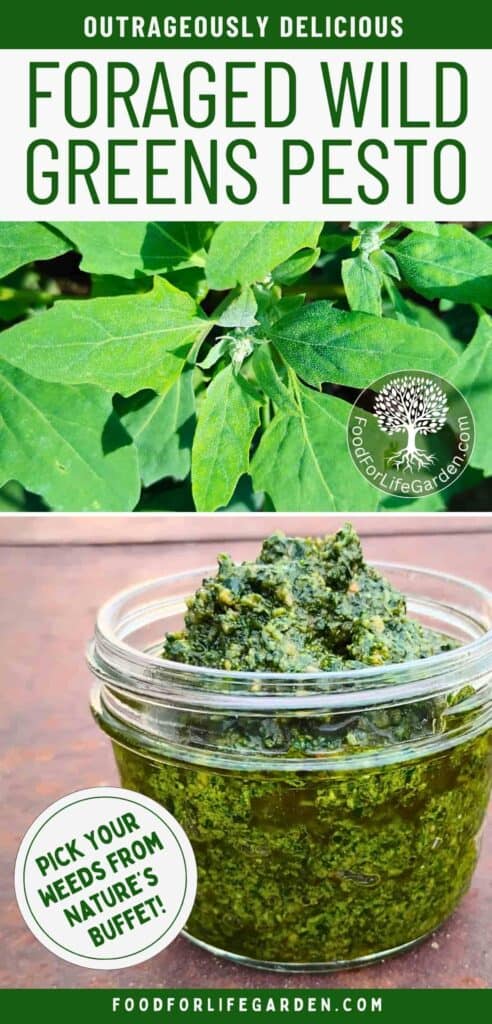
Shop This Post
Equipment
Food processor
Silicone spatula
16 oz canning jars
Squat shaped 8 oz jars
Redmond’s Real Salt
Himalayan Pink Salt
Celtic Sea Salt
Seeds:
Ramps (Bear’s Garlic) Seeds
Claytonia (Miner’s Lettuce) Seed
Purslane Seeds
Milkweed Seeds
Roasted and granulated chicory root
Foraging Books and Plant Identification Field Guides:
There are lost of foraging books, do be sure to get some specific to your location. These are some favorites I have, but I need to add some midwest books now that I’m in Missouri. I’d love your suggestions in the comments if you have some favorites.
The Forager’s Harvest, Samuel Thayer
Healing Wise, Susun Weed
A Dandelion Celebration, Peter Gail
Edible Wild Plants, Peterson Field Guides
Nature’s Garden, Samuel Thayer
For The East
Field Guide to North American Wildflowers, National Audubon Society
for the Midwest
Here is one I don’t have, but it’s on my wishlist
Midwest Medicinal Plants, Lisa Rose
For the West Coast
Northwest Foraging, Doug Benoliel
Wildflowers of the Pacific Northwest, Mark Turner and Phyllis Gustafson
Plants of the Pacific Northwest Coast, Pojar and Mackinnon
Pacific Northwest Medicinal Plants, Scott Kloos

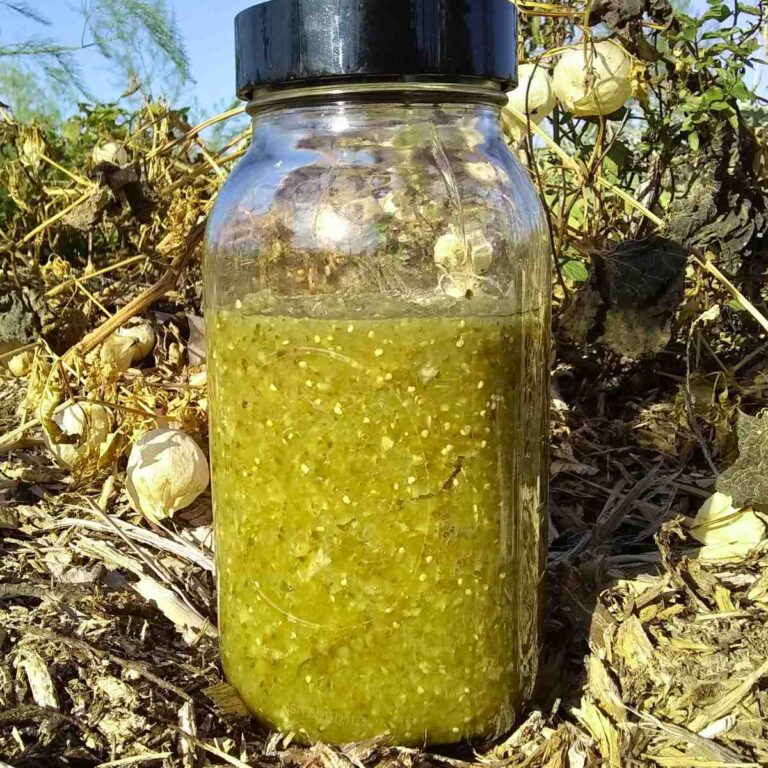
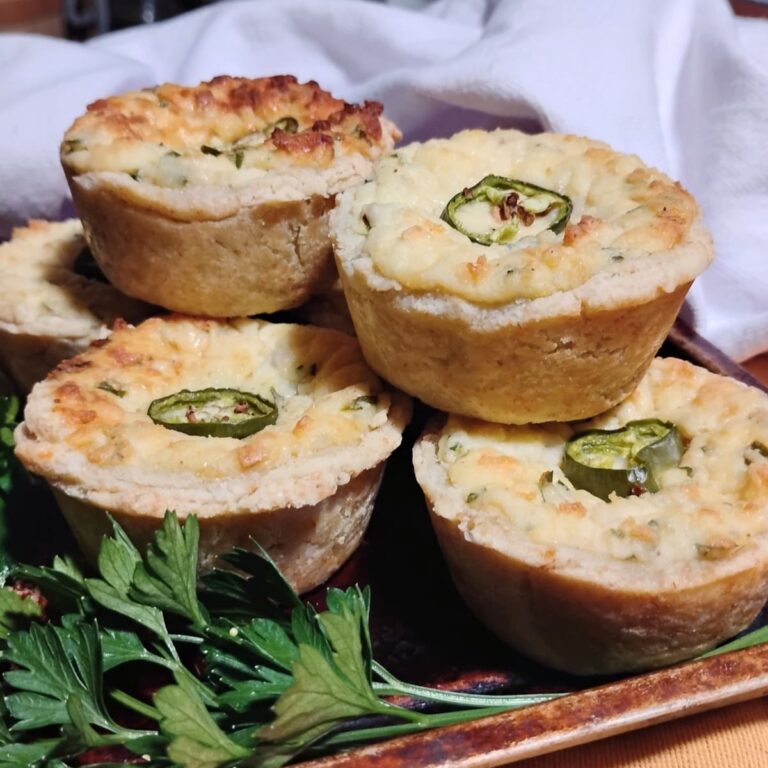
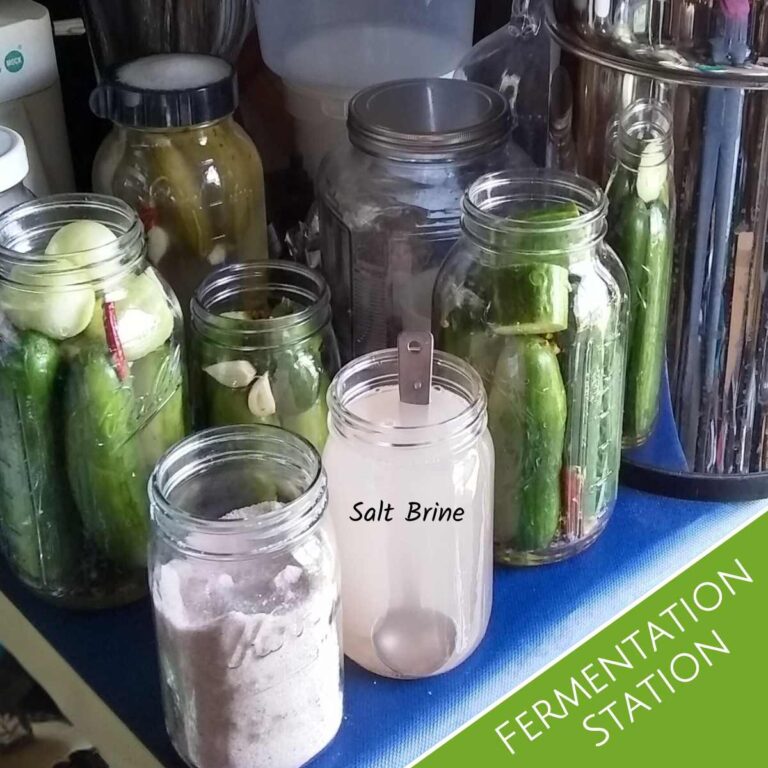

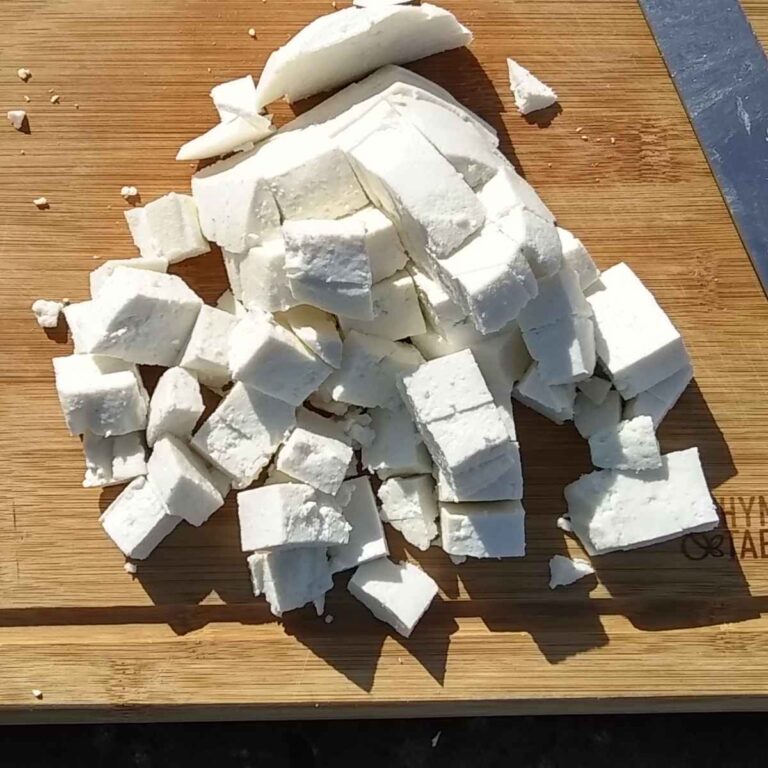
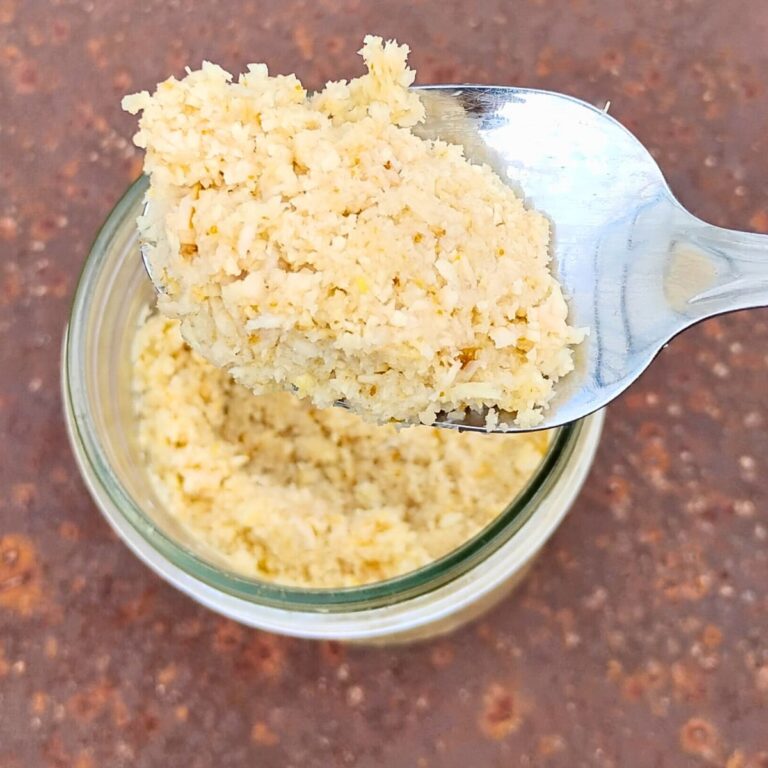
This is such a cool idea to forage your own greens! Really want to try this recipe!
It’s so easy to make and a great way to use your weeds. Hope you like it as much as I did!
This sounds delicious! I’ve always wanted to learn to forage… Actually had a foraging tour set up last year, but got rained out. I need to reschedule that.
That’s such a great idea! I was on a foraging tour once and it was so very exciting to learn about plants you never even considered eating. I hope you get to do it and I think you’ll love it!
Love most of the plants represented here! I’d be too scared to eat any milkweed, but we do cooked poke😉
I get that. It’s funny you eat poke, because I’ve been too scared to try it yet. I didn’t list it because I need to find out more. It grows all over here and I had never seen it before, but my neighbor said it’s edible when its very young if you cook it a certain way. I still need to learn how.
I love pesto. I feel like I can taste it while I am looking at your pictures and reading about it!! Thanks for sharing in so much detail!
You’re welcome! I’m glad if you find this helpful!
I love pesto so much. I love that this is so nutritionally dense. I can’t have cows milk, but sheep’s cheese I can.
That’s so interesting. I have been thinking about milking sheep in the past because I heard it’s so much easier to digest for a lot of people. Currently I have goats and all my cheeses are goat cheese.
Another excellent article to refer to for later use! Thank you!
Thank you so much! I’m glad if this is helpful for you!